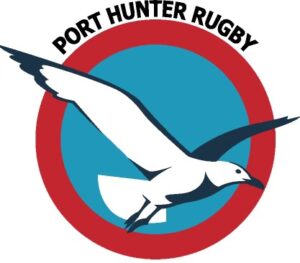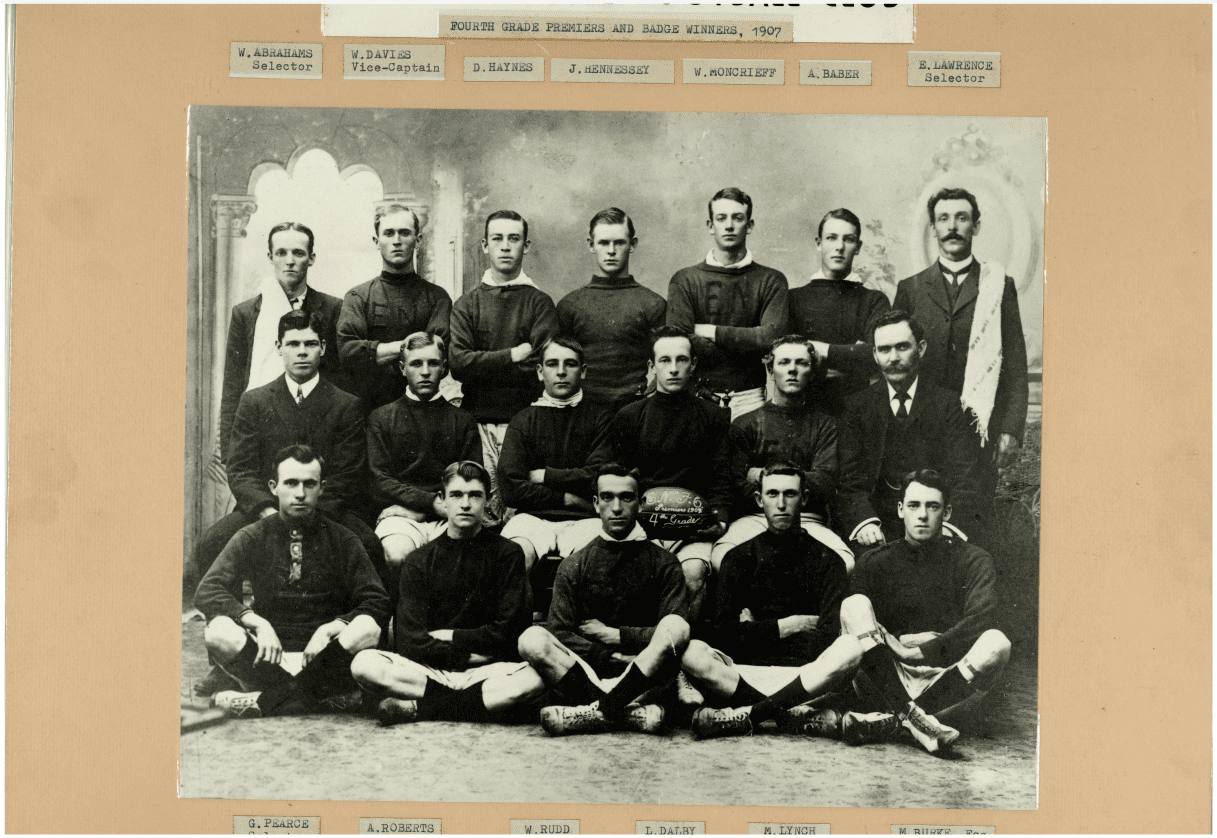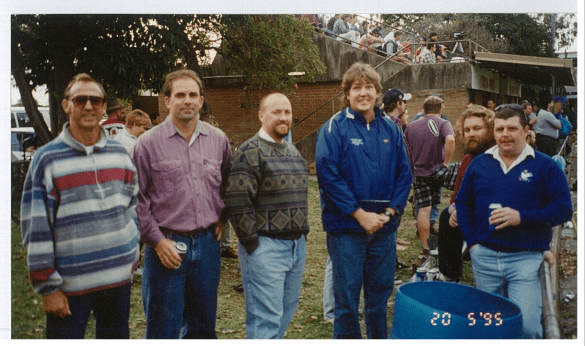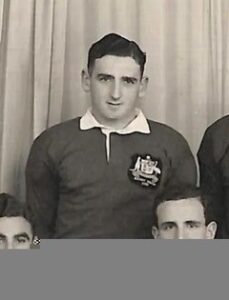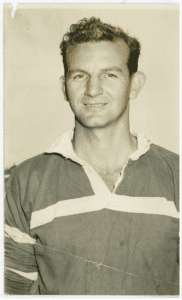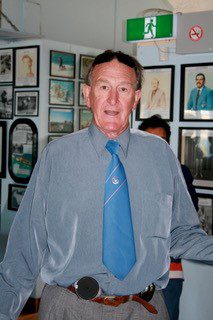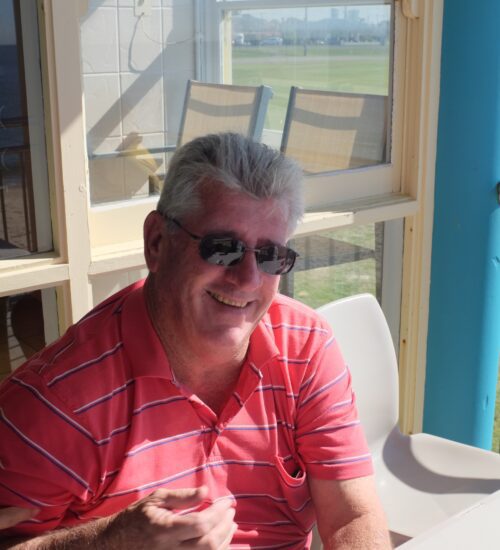The History of the Red, White & Blue
138 Years of Rugby Union in Stockton.
1886 to 2023
Contents
1) Foreword by Brian Rudder OAM.
2) Co-Authors foreword by John Bevan
3) Early History of Stockton
4) Early History of Rugby Union in Newcastle
5) Brief History of Stockton Union Club/Port Hunter Rugby (+ List when clubs were formed)
6) The Early Years – 1886 to 1929
7) The 1930’s & 1940’s
8) The Golden Years – 1959 to 1969
9) The Gradual Decline – 1970’s
10) A Little Resurgence – 1980’s
11) Formation of Tech Port – Amalgamation with Tech College
12) The Schooners
13) Newcastle Griffins – The Future
14) List of Major Office Bearers
15) List of Life Members including Life Members of Newcastle Rugby Union (NRU)
16) Representative Honours including Other Major (NRU) Honours
17) List of 1st Grade Coaches
18) List of Players who have played 100 (or more) 1st Grade Games
19) List of Players who have played 100 (or more) games (Juniors &/or Grade)
20) Grand Finals, Finals & Semi Finals played
21) Team of the Century
22) Best Players & Junior Teams
23) Best Players & Captains
24) Players from the RAAF Williamtown Base
25) Families and Individuals Who Have Given Special Service
26) Stories from the Front row- “Believe it or Not”
27) End of season Trips
28) Presentation Nights and Social Drinks
29) Rugby Reunions
30) Acknowledgments
31) Full Time
32) References and Bibliography
Front Row: W.Abrahams (Selector) W. Davies (Vice Captain) D. Haynrs, J Hennessey, W. Moncrieff, A Barber, E Lawrence (Selector)
Second Row. G Pearce (Selector), A. Roberts, W Rudd, L Dalby (Captain), M. Lynch M. Burke, Esq. (President)
Bottom Row: S.E. Felton, E.Lewis, G.Linz, E. Shearman, T. Hill
East Newcastle Fourth Grade Premiers 1907
1) Foreword
by Brian Rudder OAM
Life Member and Past President (1977-1982) Port Hunter Rugby Club
It is amazing but not surprising that the portside suburb of Stockton has a history of playing rugby union for a period of nearly 100 years spanning the past 138 years.
The statistics might be a bit of a surprise to many people – but not to former players, club officials and supporters of the Stockton and later Port Hunter Rugby Club who know the suburbs long history with early Newcastle. Stockton was one of Newcastle’s first residential communities and the first official note about a local rugby team was recorded in 1886 when Stockton played in reserve grade in the Newcastle competition.
The teams played in the colours of Red, White and Blue – hence the title of this publication – which would not have been researched and published but for the dedication and work of three great “rugby mates” of the Stockton/Port Hunter Club. If it wasn’t for the interest and tenacity of Jeff (Tangles) Brady, Peter (Peter Mac) McNamara and John (Bevo) Bevan in putting pen to paper to preserve our history we would not have the joy of reading what is in front of us today
Jeff started the task when he published the clubs 50th anniversary publication in 1982 (or was it our 96th anniversary? – see later chapters). Jeff passed away in 2016 aged 71 and his initial research was updated and extended by Peter from 2018 and then by Peter and John from 2020 until Peter passed away in mid 2021. John carried on the work and his untimely passing in April 2023 meant that Stockton/Port Hunter Rugby Club could not let the “three instalments” of club history gather dust and be forgotten.
It is a credit to Jeff, Peter and John that this publication provides a wealth of knowledge and photos about our club – in the words of John – “all three co-authors have spent many thousands of hours trying to find as much information as possible and available on our great club”. It is written in a style that reflects their individual thoughts and we honour their efforts by keeping them as part of these records.
I trust you all enjoy reading about the history of Stockton/Port Hunter Rugby Club – associated club names such as Stockton United, Port Hunter, Tech College, Tech-Port, the Schooners and the Griffins will bring back memories, and possibly raise discussion and comment.
There are some great little rugby tales (true and not so true!) about our club from when working bees were organised by club officials, members and supporters to develop Lynn Oval in the late 1800s to our social events, trips away and game day experiences. Stockton was of course during this time a working class suburb full of hard dynamic characters and personalities, and one could conclude that the club was formed and existed to give these characters a home, and made the club the amazing identity it was. For those of us who were part of it in whatever capacity remember it with affection.
In conclusion, thank you to a small band of Seagulls supporters who have assisted in the past year to ensure that our history is not forgotten and that Red, White and Blue has been published in memory of Tangles, Peter Mac and Bevo
And thank you to all the players, club officials and supporters since 1886 who have worn the Red, White and Blue and been part of the rich history of our clubs.
2) Co-Author’s Foreword by John Bevan
This history of Stockton/Port Hunter Rugby Union Club has been completed by three ex-players of the Club: Jeff (Tangles) Brady, Peter (Peter Mac) McNamara & John (Bevo) Bevan.
The first history was completed & published for the Club’s 50th Anniversary (in reality it was our 96th Anniversary) held at Newcastle Town Hall on Saturday 20th March 1982. It was completed by Jeff Brady.
Peter McNamara started to complete the second installment of our history in early 2018.
In 2020 I started to help Peter complete the history, due to his ongoing health problems.
In late June 2021, just prior to his death in July 2021, I promised him that I would complete this history. In August 2021 I started completing the third installment of our history, incorporating all three into this final history.
Most of the individual author’s words are verbatim, except for small changes due to grammatical mistakes and to conform with the final format as published.
All three Co-authors have spent many thousands of hours each trying to find as much information as possible and available on our great Club.
Due to the paucity of records and newspaper clippings etc, it has been a very difficult task to find out when a club playing under the name of Stockton or Port Hunter first started playing Rugby Union in the Newcastle Rugby Union (NRU) competition.
The results included in this history are to the best of our knowledge a true and correct record.
In The Introduction, Stories from the Front Row, and “Believe it or Not”, we have tried to show the club has many characters.
If this history has proven anything, it’s proven that our great Club has fought just as hard “off the field to SURVIVE” as we did “on the field to WIN.”
According to records found and verified, the first teams to play Rugby under the name of Stockton or Port Hunter are listed under:
1886 – Stockton (Reserve Grade) only played that year.)
1895 & 1896 – Stockton (Juniors)
1901 to 1903 – Stockton United – (1st Grade.)
Therefore, as of 2023 our Club first played Rugby in an official Newcastle Rugby Union Competition 138 years ago and have played a total of 96 years during that period.
So, in four years the Newcastle Griffins will bring up our Centenary of playing Rugby.
What an achievement for our great Club.
(JOHN BEVAN. ADV. DIP. PCM, Dip. M.M. (For Jeff Brady B.A. Peter McNamara B.A.)
3) Early History of Stockton
Newcastle and Stockton were discovered at the same time, but the establishment of a convict settlement on the southern side of Port Hunter in 1804 gave Newcastle the advantage over its north shore. Thus, the indigenous people of the Worimi nation, whose tribal area extended from the Hunter River to Port Stephens, were able to go on residing on the Stockton beach near Lynn Oval, just as they had for thousands of years, until 1870 at least.
In 1835 two wealthy settlers, Dr James Mitchell and Alexander Walker Scott, bought the southern sections of the peninsula and began to develop the town of Stockton. By the late 1840s, they had established a string of industrial enterprises along the harbour front and the place was developing so fast that Newcastle landholders were fearful that their side of the Hunter would soon be eclipsed. It seemed that Newcastle might become Stockton’s southern suburb.
A W. Scott had established a salt works and an engine works and was planning a sugar refinery as well as a railway from Newcastle to Maitland! Mitchell’s chief contribution to the developing industrial centre was a large textile works, perhaps the biggest in the colony, in the vicinity of what is now Factory Street, but it was burnt down in a fierce southerly gale in 1851. The wind may have blown sparks from the steam engine furnaces onto the weatherboard buildings, but the locals were convinced that an arsonist was responsible and a large reward was unsuccessfully offered for his arrest. Most of the Stockton manufacturers went into decline after 1850 but shipbuilding and timberyards flourished there in the next decade. Thus, the village which had been very largely composed of spinners and weavers became the home of shipwrights and sawyers and the shopkeepers who served them.
The river was a thoroughfare for the residents and all manner of craft plied its waters. There were boats for hire, water boats serving the ships, butcher boats for the same purpose, tugs, sailors, and steamers and for those who came ashore on Stockton there were several hotels. Chief among these was the General Washington where, in the 1860s they played Skittles, practiced archery, and drank tea, as well as other stronger beverages, on Sunday afternoons.
All of this was changed by the coming of the Stockton Coal Company whose mine, situated near the harbour on the site of the present housing commission flats, came into full production in 1886.
Consequently, the school population doubled, from 205 to 396 in one year, accommodation became extremely scarce and land sales boomed.
The coal under Stockton was Newcastle’s best, the famous Borehole seam, and here it was thicker and particularly suitable for making gas. Thus, the company should have prospered but there were technical problems because of water entering the pits and industrial troubles and by 1896 a serious mine disaster when eleven men lost their lives. This incident is commemorated by the gates to Lynn Oval. Nevertheless, large quantities of coal went from Stockton to the other Australian States and to ports as far away as Hong Kong, San Francisco and Valparaiso (Chile)
By the end of the last century the Stockton Colliery was running short of coal but by then the town was well enough established to survive the closure of the pit. The days of shipbuilding were also over and as its major manufacturing and mining functions faded away, Stockton became a residential suburb. The opening of the first State Dockyard on Walsh Island, (now a part of Kooragang Island) in 1913 and the selection of Newcastle for the B.H.P. Steelworks which opened two years later, provided a new stimulus to Stockton. Workers could travel very conveniently to both of those sites by ferry.
Stockton was incorporated in 1889 and its unique council chambers stood on the site of the R.S.L Club in Douglas Street. Of course, many of its residents had been born in the United Kingdom and there was a strong Welsh minority among them. They carried on their native traditions of language and choral work in annual eisteddfods. The strong British influence is evident too, in the naming of so many streets, for example Hereford, Dunbar, Douglas, Flint, etc.
Stockton could easily have been an island if the Hunter River, on the one side, and the South Pacific Ocean on the other, had had their way. Thousands of years ago the river used to exit to the north of Stockton and the ocean still threatens occasionally to cut the peninsula in two. Moreover, the town’s relative geographic isolation created strong loyalties and in the old day’s rivalries between it and its rivals, particularly Carrington, sometimes boiled over. Stockton has a colourful history and continuing strong links with the river and the ocean that created it and provided employment as well as recreation for its people.
In fact, it would not be going too far to apply to the town a remark that was first applied to Newcastle in 1866: “It was essentially a seaport and a coal seaport, every third house sold slops or ropes or blocks or some of the many other articles required by those who go down to the sea in ships.”
Over the years, Stockton has had a warm and important history. Our widely known capacity to motivate the feelings and intrigue a nostalgia for many people.
Stockton is the only suburb of Newcastle on the northern side of the Hunter River (Harbour) and has a very interesting testimony. The Stockton peninsula was originally the land of the Worimi people who knew the land as “Burrinbingon”– The land of plenty. The first Europeans arrived when several convicts were shipwrecked there on the Lady Norfolk in 1800.
In the 19th Century, until the “Stockton Gallery Disaster” in 1896 which killed 11 miners, Stockton was regarded as an industrial and mining suburb. During the early to mid-20th century, it was regarded as a dormitory suburb for workers at the slab dockyard and the BHP.
It was not until the 1980’s that it started to lose the “Working Class” stigma, due to the closing of the state dockyard and BHP and the gradual increase of land value. In the early 21st century the price of houses and land exploded.
Now Stockton is regarded as one of the most sought-after suburbs to live in Newcastle, due to its natural beauty, beach and proximity to the city and Port Stephens. Stockton has a proud history of its sport.
It has an A-class golf course – Newcastle at Fern Bay, a Tennis club, Bowling club, Cricket club, and Surf club (up until the 1960’s – they were two.) North Stockton and Stockton, until North Stockton folded. Soccer club, board riding club, most are still active and have juniors and seniors. Over the years there has also been – Rugby Union Club Stockton (Seagulls), Rugby League Club Stockton (Sharks) at senior and junior levels, Hockey Club, Netball clubs, Baseball club, women and girls Marching club.
Apologies for any omission/s.
4) Early History of Rugby Union in Newcastle
The first reports of a sport like rugby being played in Australia date back to the 1820s when visiting ship crews would play army teams at Barrack Square in Sydney. However, it wasn’t until 1864 that the first formal club was formed at Sydney University. The metropolitan competition was born a decade later.
Rugby union was first played in Newcastle on June 5, 1869, 46 years after William Webb Ellis first picked up the ball and ran with it at the Rugby School in England.
From the inauspicious beginnings in 1869, the current Hunter & Newcastle Rugby Union is now enlisted as the strongest region in country Australia.
An eight-man Volunteer Artillery team challenged United Cricket Club (11 players) at Centennial Park, Cooks Hill. The game burst into a brawl, dubbed the battle of St Johns Green, with the result of the game and the fight unknown.
The Newcastle Football Club was founded at a meeting at the Ship Inn on May 1, 1877. Maitland and Wallsend clubs were established later that year and were followed by Advance (1880),West Maitland (1885), Oriental (1885), Union (1885), Ferndale (1885), Waratah (1885),Raymond Terrace (1886), Stockton (Reserve grade) (1886), Carlton (1887), Centennial (1887),Lambton (1888), Wickham Albion (1888) Greta (1890), Stockton United (1901) Stockton Wanderers (1902).
The Newcastle Rugby Union was formed in 1888 and continued until 1915
(World War I), when all competitions were suspended.
The game re-emerged in 1926 with a match between GPS Old Boys (now Wanderers) and Novocastrians at Empire Park.
During the early years, the union Secretary suspended a Lambton player for carrying a shot-loaded whip onto the field.
The same Secretary warned Singleton Pirates that unless they treated visiting teams and referees with more respect, the pirates would be disqualified.
Players and Referees from Newcastle selected as “Wallabies” and Test Referees.
Over the years the following players and referees have been selected from the NRU.
Wallabies:
Maitland winger Charles White was the region’s first Wallaby, playing in the historic opening Test in Australia against Great Britain in 1899.
Noted Newcastle physician Dr Herbert Moran led the Wallabies on the first tour of Great Britain and North America. Before each game they performed a war cry that was described as an Australian version of the New Zealand Maori haka.
In total, 24 players from the region have worn the green and gold, including greats Cyril Burke, Neil (Noodles) Adams , Walter Cobb, Dick Cocks, Terrance Curly, Declan Curran, Keith Walsham, Michael Fitzgerald, Will Gardner, Ron Harvey, Peter Horton, Michael Jenkins, Jubert Jones, Sydney Malcolm, John Marshall, Ronald Meadows, Joshua Stevenson, Patrick Walsh, Keith Percival, Charles White, Steve Merrick, Luke Burgess John Hipwell and the dual-code international Phil Hawthorne.
Burke played 26 Tests over a decade from 1946 and is at the top of a procession of 11 Wallabies halfbacks to have hailed from the Hunter. Fred “Possum” Wood began the production line in 1907 and was followed by Josh Stevenson, Harold “Slogger” Snell, Syd Malcolm, Jan McShane, Cyril Burke, John Hipwell, Dominic Vaughan, Steve Merrick, Josh Valentine and Luke Burgess.
Apart from his Test appearances, Burke won the Anderson Medal for the region’s best and fairest player four times – a record matched by Merrick – and became a renowned coach of the Waratahs.
Merrick has the distinction of being the last player plucked from NSW Country to play for the Wallabies when selected for two Bledisloe Cup games against the mighty All Blacks in 1995.
Burgess, a Maitland junior, was the last home-grown product to wear the green and gold.
The 1960’s and early 70’s era was the best decade for the selection of Wallabies from the NRU.
With the following four players being selected:
Keith Walsham (University), Phil Hawthorne, Ross Turnbull and Mick Jennings (Wanderers), John Hipwell (The WaratahsClub). Peter Horton (The Waratahs Club) Early 1970’s).
Referees Who Controlled Tests Internationals.
Though outnumbered by the playing counterparts, Newcastle has supplied two Test referees.
Bob Fordham controlled seven Tests from 1983 to 1987, including officiating at the inaugural
Rugby World Cup in 1987.
Sandy Mac Neill had the whistle for 16 Tests. His achievements included officiating at the 1991Rugby World Cup and being in control when South Africa were readmitted after the downfall of apartheid, against New Zealand at Ellis Park in 1992.
Popular optometrist, John Miner ultimately became one of the most appointed referees to countless NSW and Australian committee positions and went on to become the Referee Selector and Appointment Chairman for the International Rugby Board at the 1987 and 1991 World Cups.
NRU PRESENT DAY:
Currently (2022) the Newcastle and Hunter Rugby Union consists of 19 senior clubs in their division, 96 junior teams from under sevens to under eighteens and a women’s competition. It also has a redeveloped home at No.2 Sportsground at a cost of over seven million dollars to host all of its major matches.
5) Brief History of Stockton Union Club/Port Hunter Rugby (+ List when clubs were formed )
According to the available records and documents held by Newcastle and Hunter Rugby Union Inc. and Stockton/Port Hunter Rugby Club, available press clippings found.
The first club playing under the name of Stockton or Port Hunter was as follows:
1886 – Stockton (Reserve grade only) Seniors (Div 1)
1895 – Stockton (Juniors) only
1901 – Stockton (First Grade) (Div 1)
A full list of names and colour, if known, of all the clubs who have played from 1886 to 2023 are below:
1886 – Stockton (Reserve Grade) – colours not known.
1895 – 1896 – Stockton (Juniors) – Blue with Gold Sash.
1901 – 1903 – Stockton United (1st Grade) – Red, White, Blue.
1902 – 1906 – Stockton Wanderers (1st Grade) – Blue with Red Stripes.
*(Stockton had two first grade sides in 1902 and 1903)
1907 – 1915 – East Newcastle District (1st Grade) – Red, White, Blue
1924 – Port Hunter (1st Grade) – Red, White, Blue
1930 – 1934 – Port Hunter (1st Grade) – Red, White, Blue
1936 – Stockton (1st Grade) – Red, White, Blue
1941 – 1943 – Port Hunter (1st Grade) – Red, White, Blue
1959 – 1974 – Stockton (1st Grade and Juniors) – Red, White, Blue
*(Juniors formed in 1960)
1975 – 1990 – Stockton (1st Grade & Juniors)- Red, White, Blue
1975 – 1990 – Amalgamated with Nelson Bay (3rd Grade)
1975 – 1979 – Amalgamated with Medowie (4th Grade)
1980 – 1990 – Amalgamated with Tilligerry Tigers (4th Grade)
1991 – 1996 – Tech Port (Griffins) – (Port Hunter Amalgamated with Tech to stay in the first division)
– Red, White, Blue
*Tech College was formed in 1948 to 1990 – Black with two thick gold bands in centre of the jumper.
1987 – 1990 – Stockton (Stuffed Seagulls) Golden Oldies – Red, White, Blue
1997 – 2000 – Stockton (Schooners) (2nd Div) – Red, White, Blue
1997 – 2023 – Newcastle Griffins (2nd Div) – Red, White, Blue (Changed name from – Tech Port – Currently have senior and junior teams).
6) The Early Years – 1886 to 1929
Stockton/Port Hunter Rugby Club will celebrate its 137th anniversary since its foundation as a rugby club in 2023. However, the early origins and much of the subsequent history of the club are difficult to trace due to the paucity of records and information.
As stated previously, the first club to play under the Stockton name was a reserve grade team who only played one year in 1886.
Records and documents, currently in the possession of the NRU, do show that a junior Rugby Union club named Stockton was formed and competed in both 1895 and 1896.
The Secretary of the club was Mr R Lynn, (after whom Lynn Oval was named when it was constructed in 1924) and the only player’s names that can be traced are a G Elvidge and T Dever, through correspondence with the then Northern Division of the Southern Rugby Union, which administered both Newcastle and competitions throughout Northern New South Wales. The club entered teams in two junior divisions and had the colours of blue with a gold sash. However, the club seems to have ceased to function at the end of 1896, as it is not listed as competing in Northern Branch competitions in 1897.
In 1901 a club called Stockton United was formed and competed in the Newcastle First Grade competition in the years 1901, 1902 and 1903. The club had the colours of red, white and blue and its 1901 Secretary was Mr W Towers.
In 1902 a second club, called the Stockton Wanderers was formed, which also competed in the first grade competition with the colours of blue with a red stripe.
In 1904 Stockton United apparently did not compete in any competition in Newcastle Rugby and Stockton Wanderers changed their colours to blue with a red, white and blue stripe, so possibly the two clubs may have amalgamated. Stockton Wanderers was again entered in the 1905 competition with Mr. O Abrahams as Secretary and again in 1906 when Stanley Hudson was Secretary. However, the club was not entered in the 1907 Newcastle competition.
In either 1907 or 1908 the Northern Rugby Union re-structured its competition by introducing ‘district’ sides. Stockton became part of the district called East Newcastle, which entered teams in four grades from 1908 – 1915. This may have been responsible for the demise of the Stockton Wanderers club.
East Newcastle won the 1907 4th Grade premiership and the 1912 2nd Grade premiership.
In 1915 East Newcastle reached the Ist Grade premiership final and drew 6-all with West End Maitland club. The game was scheduled for a replay, but the replay was never held as both sides were severely depleted by enlistments in the A.I.F. This also saw the end of any Rugby Union competition in Newcastle until 1924.
In 1924 the Newcastle Rugby Union was re-formed and a new competition commenced, containing eventually all of the clubs presently competing.
7) The 1930’s & 1940’s


Port Hunter Club was formed after a meeting held one Sunday morning in 1931 in Stockton Surf Club, which was addressed by Joe Palmer, a former captain of Newcastle Surf Club and later a life member of both the Newcastle and New South Wales Rugby Unions.
Before this, a Stockton Rugby League Club had functioned for several years and had paid a ground rental of £20 to Stockton Municipal Council through the Lynn Oval Board. However, for the preceding two or three seasons, the club had failed to pay this rental and had been deprived of use of the oval by the Council. Under these circumstances and following comments made by Joe Palmer, the meeting decided to form the Port Hunter Rugby Union Club. Mr V G Hodges was elected President, James Tobin Secretary, Eric Benson Treasurer, and Norm Brady Social Secretary.
The club entered teams in the Ist and Reserve Grade competitions in 1932 (as the meeting in 1931 had been held too late in the season to enter in that year and also due to the fact that it could not secure a suitable ground.) At least twelve members played with Newcastle teams in 1931, presumably to gain experience. In 1931 club members also performed a considerable amount of voluntary labour in preparing Lynn Oval for the 1932 season. By 24 February 1932, the club had over 45 players and approached the Council for the use of Lynn Oval. It had its first trial game on Lynn Oval on 7 April 1932 against Wanderers.
“Excerpts Of a speech by an unknown original”
“We were into the start of the great depression and most of the boys were jobless. A deal was arranged with the council that if they provided the equipment the lads would provide the labour to make a playing field North of the tennis courts. This area was covered with dense tee-tree scrub and sloped from the roadway to the sand dunes. The equipment provided comprised skips and rails, horses and scoops and of course a supply of No5 banjos. I had only limited experience with this project and only worked on it when short time at the works was introduced. Some of the fellows, mostly members of the Surf Club, worked pretty well full time on the job. The work was supervised by the council foreman and equipment was supplied each day according to the labour available. Horses were supplied provided there were fellows available who could handle them. The regular volunteers became pretty skillful with the horse and scoop technique.
As you can well imagine there were some very amusing stories about runaway skip rides and the unpredictable behaviour of some draught horses. In the afternoon the horses were ridden back to the ballast ground stable. This gave some scope for frivolity when draught horses, harnesses flapping, became race horses eager to get the nose bag on.
The efforts of the volunteers convinced the council that maybe these footballers were not such a bad bunch after all and the use of Lynn Oval on a 50/50 basis with the baseballers was restored to the football players. Dalby Oval was finally top dressed by the council, but the records must show that it was carved out and created by the footballers of Stockton for free”
No complete list of players and club officials is available, but it would seem that C Brien was the 1st Grade Coach and possibly A Buchanan or A McInnes was the Reserve Grade Coach and that players included:
N Atkins, Richard Antcliffe, T Bland, W Boyd, N Brady, V Brady, C Brien, A Burt, M Bevan, J Coleman, J Chadban, J Dumbrell, T Dives, W Engel, C Elferson, E Felton, J Henderson, E Benson, H Henderson, A Hunt, C Hunt, J Johnson, J Knight, E Kinnaird, A Hodges, A McInnes, V Maher, F Mayo, E Nelmes, N Nalder, N Pitt, I Tams, G Terry, W Tobin, S Watt, T Warland, and C Williams.
The club colours then, as now, were red, white and blue with the jumper having a similar design to the present one. Either East Newcastle or the Stockton Wanderers club may have also previously been called Port Hunter, as there are frequent mentions in newspaper reports of the club’s activities of an earlier Port Hunter club some 23 years before 1932.
In the 1932 competition, the clubs entered were Wanderers, Merewether-Carlton, Maitland, Surf Club and Boolaroo (the last two combined in 1933 to field a Ist Grade side called Surf Club-Boolaroo) in the 1st Grade competition and Nobby’s Wanderers, Y M C A and the Waratahs in Reserve Grade.
In its first season of competition, the club met with considerable success. The 1st Grade side was undefeated at Lynn Oval during the year and won eleven games, drew one, and lost four. The Reserves won eight games and lost seven.
Eight members: V Brady, H Williams, T Bland, W Boyd, J Dumbrell, C Elferson, W Tobin, and N Nalder were selected in the Newcastle Possibles -v- Probables Game to select the Newcastle team to meet the All Blacks. W Tobin and T Bland were then selected for the Newcastle team to meet the All Blacks. H Williams and C Elferson were then selected in the Newcastle team to play the Navy and N Nalder was selected in the Newcastle 2nds side. The Ist Grade at the end of the season were equal second in the competition with Maitland and unfortunately were defeated 15-3 by Maitland in a play-off to meet the competition leaders Merewether-Carlton. In the final, Maitland defeated Merewether-Carlton to win the 1932 premiership.
The 1932 Ist Grade side was involved in one stormy incident during the season. Port Hunter was playing Merewether-Carlton at No. 2 Sportsground on 22 August 1932. Shortly after the commencement of the second half, a Port Hunter player was cautioned by the referee, replied twice to the referee’s warnings, and was then sent off. Ten other members of the Port Hunter side then walked off the field, and the game was subsequently abandoned. (Luckily, we were losing 11-0 at the time anyway).
In 1933 the Reserve Grade side were undefeated until they met Merewether-Carlton in the Semi Final and lost it 6-3. They then reversed this decision by winning the Grand Final against Merewether-Carlton 8-3 to become the first team of the club to win a major premiership. The team was coached by A Buchanan and included: I Felton, R Robinson, R Hyman, M McCruvie, C Williams, A Deveraux, R Furey, E Nears, F Mayo, E Benson, R Antcliffe, G Terry, S Watt, S Anderson, N Nalder, E Foster, J Williams, T Warland. A Limeburner and H Monk. W Fisher was Club President, J Tobin Secretary and Tom Dives trained the team.
In 1934 the club fielded sides in Reserve and 3rd Grade competitions only, against teams such as Y M C A, Mayfield Methodists, North Newcastle, Hamilton Methodists, Cooks Hill-Carlton, Rovers and Nobby’s All Blacks as well as more traditional rivals of Maitland, Boolaroo and Merewether-Carlton. However, the club did not have a very successful season. The Reserve Grade won four games and lost seven, while the Third Grade won only one game, drew one game, and lost five before forfeiting two games and apparently collapsing late in the season and being withdrawn from the competition.
In 1935 Port Hunter did not enter any of the NRU competitions.
In 1936 a side played in the Reserve Grade competition which was, surprisingly, called Stockton rather than Port Hunter.
From 1937 until 1940 inclusive the club did not compete in NRU competitions. In 1941 Port Hunter again entered teams in the NRU First Grade and Under 21 competitions, but the Under 21 side was withdrawn from the competition very early in the season. The First Grade competition included Waratah-Mayfield, Wanderers, C Y M S, St Patrick’s, United Services and Merewether-Carlton. The side won three games (including one forfeited to us by Waratah-Mayfield) and lost eight.
In 1942 and 1943 Port Hunter was in the First Grade competition only, but after this, the club did not enter any NRU competition for sixteen years.
8) The Golden Years – 1959 to 1969
The eleven years from 1959 to 1969 were not only the golden years for Stockton Rugby Club but for the NRU also. This was due to the number of players from the Newcastle competition who were selected to play higher honours for the Wallabies, NSW and NSW country teams.
I believe that the 1960’s was the best decade in the history of the NRU since its inception in 1888.
During this decade the following players were selected to play for the Wallabies: – Keith Walsham (Wing) from University, Phil Hawthorne (5/8), Mike Jenkins (Hooker), Ross Turnbull (Front row) from Wanderers, Michael Fitzgerald John Hipwell (Halfback)(1960’s) and Peter Horton (Hooker) (The WaratahsClub) (Early 1970’s) Don Wroe (Breakaway) played for NSW (1960’s) from Wanderers.

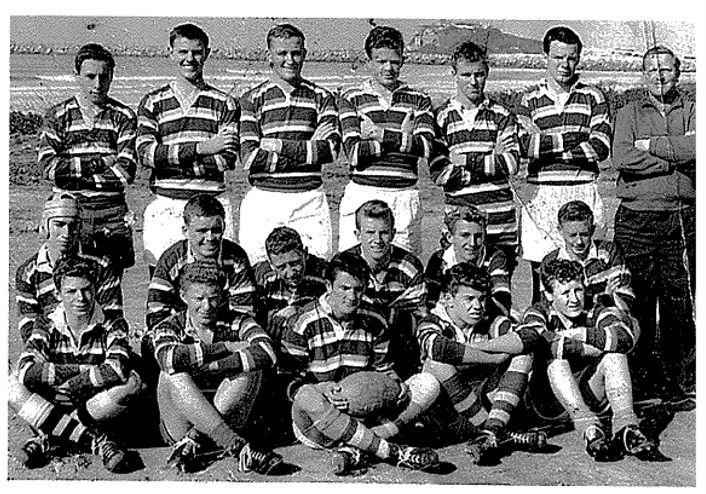

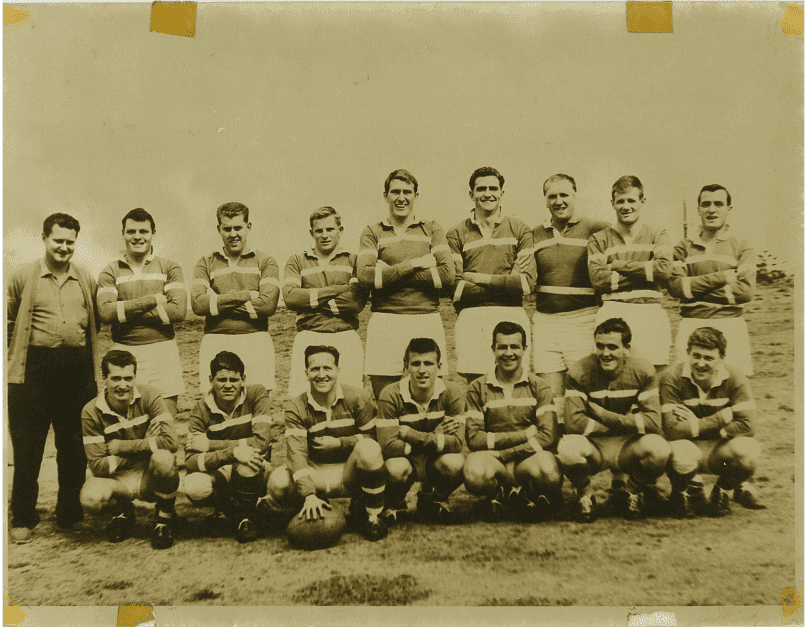
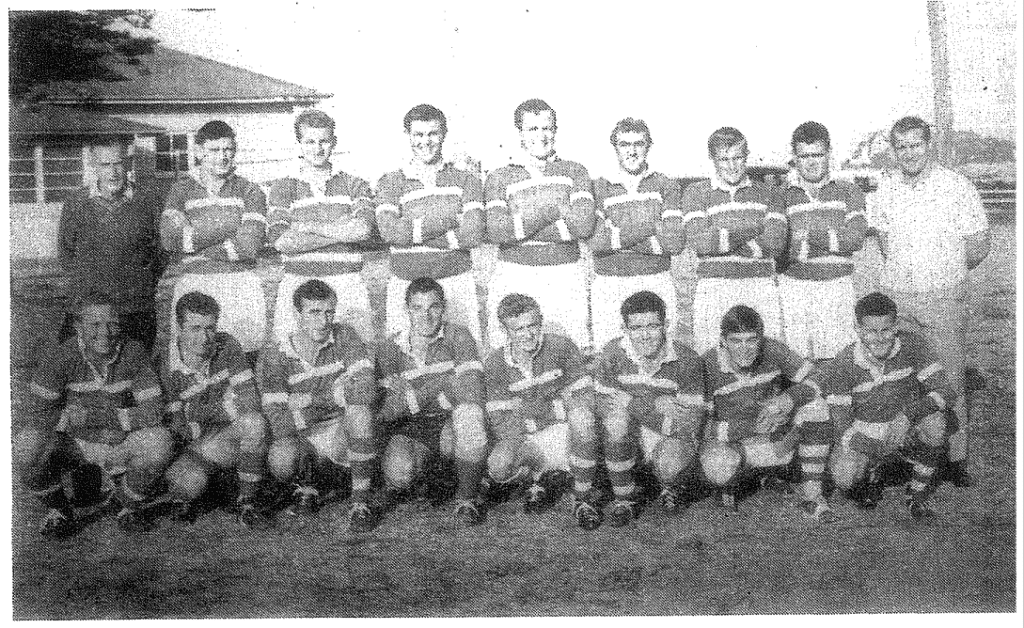

Stockton Rugby Club – Reformed in 1959
Our club reformed as Stockton Rugby Club in 1959 with L. Davies (President), Russell Stokes (Secretary), Bruce Stokes (Treasurer), “Pommy” White (Coach of 1st Grade). Russell Stokes was the reserve grade coach and Reg Stokes was 3rd grade coach.
Note: Up until late in 2022, it was always thought that Dr John Blomley was the inaugural 1st grade coach in 1959. However, it was verified by Terry Davies son of the inaugural president W (Bill) Davies that the coach in 1959 was “Pommy” White (Christian name not known. He was a front rower from the RAAF).
This was because Dr Bromley couldn’t play outside of Stockton due to his commitment as a partner in a doctor’s practice. He also didn’t want to coach for the same reason. The stimulus of this reformation as a rugby union club seems to have been the prevalent harsh conditions by the North Newcastle (1st Div) rugby leagues club on the Stockton (2nd Div) Rugby League Club.
The teams playing in the NRU competition in 1959 were:
Stockton, Wanderers, University, Maitland, Merewether, Carlton, Boolaroo, ‘The Waratahs’. Stockton entered teams in 1st grade, Reserve grade, and 3rd Grade competitions. The 1st grade then reached the final of the Alderton Cup which they lost to Boolaroo.
Players who played in the 1st-grade team throughout the season were:
“Pommy” White, John Blomley, Jack Dennis, Ross Wilson, Reg Terry, Don Terry, Bruce Stokes, Russell Stokes, Reg Stokes, Ken Knight, Bob Cox, C. Lacey, K. Kerr, Roy Gorst, John Kearns, Reg Waters, Ron Eaton,Kevin Bailey, Ray Bourdain, Brian Cox.
The following persons were on the committee and/or supporters in the inaugural year.
Bill Davies (President), Bill Jackson (Deputy President), Russell Stokes (Secretary), Ron Eaton (Treasurer), Bruce Stokes, Reg Stokes, Bill Robson, Roy Gorst, Jack Day, John Hailstone, Keith Mahaffey, Neville Stirrat, John Lindstrom, Kevin Bailey.
1960 – The club expanded and entered first grade, reserves, 3rd grade and entered teams in the NRU junior competitions. Playing in under 14’s, under 16’s, and under 18’s divisions.
The 1st grade captain/coach was Jack Davies. There are no records of the reserves or 3rd grade coaches. However it is considered that they were the same as 1959, Russell Stokes (reserves) and Reg (Stokes) (3rd Grade).
In their first season (1960) the junior teams were very successful with all players in the final series.
U /14’s were beaten by Maitland 14–12 in the grand final.
U /16’s were Minor Premiers and lost 6–3 to the Waratahs.
1961:
1st grade captain coach was Bruce Stokes (Jack Davies was transferred from Williamtown by RAAF )
Lower grade coaches – not known.
Reg Terry came 2nd in the NRU Anderson Medal (best and fairest player).
U/14, U/16, U/18 – All lost the grand final – Best won the junior club championship point score.
1962:
1st grade captain/coach Reg Stokes
Reserve Grade – lost final,
U/18’s – lost final
U/16’s -Undefeated Minor Premiers – Lost grand final (6–3) to the Waratahs.
Robert Haynes- U/18’s – selected in NSW U/18’s
Newcastle teams:
John Bevan and Terry Davies – U/16’s – NSW Country & Newcastle Teams.
1963:
1st grade captain/coach – Jack Dennis.
Bob Cox – First 1st grade player to be selected to represent NSW Country v City.
U/18’s – John Bevan and Terry Davies – NSW Country – Newcastle
U/16’s – Lost Grand Final
U/14’s – Major Premiers.
1964
1st Grade Coach– Jack Dennis.
Ernie Worrell – selected for NSW Country v –City (from 1st Grade)
Reserve grade – Major Premiers – beat the Waratahs 14-12 in the grand final.
Note – They were the first team from Stockton to win a grade championship since 1932 (Port Hunter).
The team was a combination of experienced and junior players. It was coached by Russell “Sniffy” Stokes.
1st Grade – Lost Semi-Final.
U/18’s – Undefeated Minor Premiers – Lost grand final (6–5) to the Waratahs
U/16’s – lost final.
U/14’s – Major Premiers
U/12’s – Minor and Major Premiers.
Terry Davies (Capt), John Bevan, and Kevin Jackson were selected to play for the Australian U/18’s -v- Rest after the Australia championships carnival. Terry Davies (Captain), John Bevan, Kevin Jackson, Mick Hunt, Lindsay Gailey, Paul Corbett – selected in NSW U/18’s (The teams selected from city and country).
For Australia championship carnival – Terry Davies (Capt.), John Bevan, Kevin Jackson, Mick Hunt,
Lindsay Gailey, Paul Corbett – selected in NSW Country team.
Ross Wilson was coach of the Newcastle, NSW country and NSW U/18’s teams.
Note: Many of the above teams went on to reap a succession of representative honours in the following years when they played 1st grade.


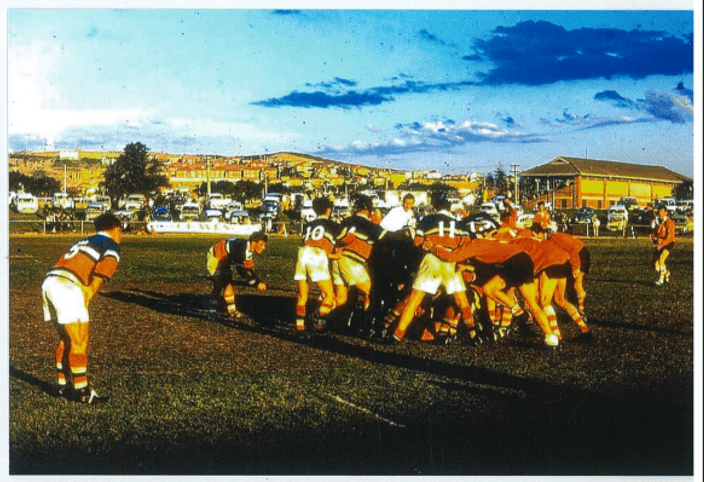
1965
1st grade coach Jack Dennis
John Bevan – Played for Newcastle and Newcastle U/19’s.
Bob Cox – was the first player to play 100 1st-grade games for Stockton Rugby Club.
U/18’s – lost grand final replay (After drawing the first game played). Note: What close results.
U/16’s – major premiers
U/14’s – undefeated minor and major premiers.
Seniors and juniors – Won the Presidents Cup point score. – the first time. Great result.
1966
The club fielded 3-grade teams as well as all junior sides.
1st grade coach was Jack Dennis.
1st Grade played in three semi-finals drawing the first and second and losing the third 9-3 to Merewether Carlton.
John Bevan – NSW Country (to play City and Qld Country).
Larry Maher and Gary Balcombe – NSW Country U/18’s
Ken Knight played 100 1st grade games
Ken Knight – Northern NSW team to tour NZ
U/18’s – Lost final
1967
1st Grade captain/coach Jack Dennis
John Bevan and Peter McNamara – NSW Country (v-City)
John Bevan – NSW country tour NZ
Jack Dennis and Ross Wilson played 100 1st-grade games
John Bevan was suspended for 9 weeks and went to rugby league.
1968
1st grade captain/coach – Geoff Hickey – NSW Country U/18’s
1st Grade lost the grand final to the Waratahs 9–3. This was the first 1st grade grand finalist since 1932.
Peter McNamara – NSW Country v City
The club fielded all 4 senior grades as well as a U/18 team.
Many of the players in the grades were former junior players and the club recorded one of its most successful seasons in 1969.
1969
The 1st grade side coached by Jack Dennis and captained by former junior Terry Davies reached the grand final undefeated only to be beaten 14-13 By Maitland (in the last minutes of the game).
3rd grade side (Coached by Barry Mullard) and 4th grade side (coached by John Alterater both lost semi-finals.
Peter McNamara – NSW Country v City
Reg (Snags)Stokes – became the club’s 1st life member.
In 1969 a Stockton team of somewhat lesser ability gained the unexpected distinction (Plus considerable notoriety) of playing Brisbane Western Suburbs first grade XV at Ballymore Oval in front of a crowd numbered in the thousands, as the curtain-raiser game for the Barbarians versus the Queensland Presidents XV, on an end-of-season trip.
The Stockton side (plus the odd ‘ring in’ or two) pushed the Brisbane side to its limits before losing narrowly and winning the approval of the Ballymore crowd on and off the field. Their unique training methods and sociability both before and after the game were also commented on by the many Brisbane residents (mainly female) who came into contact with them. No more can be said of this without the risk of libel cases or actual bodily assault. Naturally, the “cone of silence” came into effect and has never been lifted.

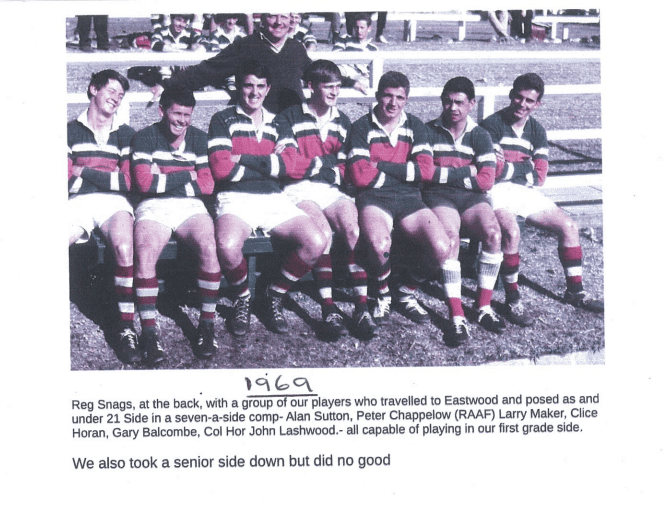
The correct names for the 1969 photo above are as follows:
L to R . Alan Sutton, Peter Chappelow, Larry Maher, Clive Horan, Gary Balcombe, John Hor, John Lashwood.
9) The Gradual Decline of the Club– 1970’s
After the golden years of the 1960’s, especially the grand final defeats in 1968 and 1969 of our 1st grade team. Starting in the 1970’s the club entered a period of declining fortunes. First it lost all of its junior sides over a short period, then It also saw the more experienced players “drop out’ of the active side of our club.
1970
1st grade coach – Jack Dennis
Bill Robson – Life Member
1971
1st grade coach – Jack Dennis
Jack Dennis – Life member
Peter McNamara – 1st Anderson medal (NRU best and fairest)
1972
1st grade coach Jack Dennis
1973
1st grade coach – Jack Dennis
Jack Day, Tim Mahaffey – Life Members
1974
1st grade coach Jack Dennis
1975
1st grade coach – Jack Dennis.
Alan Sutton – 100 1st grade games.
Brian Griffiths – 2nd Anderson medal (NRU Best and Fairest)
In an attempt to revitalise interest in the club the committee changed its name from Stockton to Port Hunter Rugby Club. Despite this, we still experienced many problems in fielding four grade teams.
1976
1st grade coach – Geoff Stewart (Only 8 games) The players sacked him and coached themselves for the remainder of the season. Has to be one of the only times ever in rugby that a coach has been sacked by players. That’s our fighting spirit – John Bevan.
U/18’s – Junior team re-formed
Doug Terry – NSW (CHS) NSW country U/18’s
Neil Skillen – 1st Ray Woolf Medal (NRU Award)
1977
1st grade coach Ken Grainger
1978
1st grade coach Ken Grainger
Noel Burns – 100 1st grade games
In 1978 Port Hunter considerably augmented its playing strength when rugby clubs were formed at Nelson Bay and Medowie. Both clubs joining Port Hunter as the 3rd and 4th grade sides respectively.
Both 3rd and 4th grade reached the semi-finals.
1979
1st grade coach – Bill Van Rugge
3rd grade (Nelson Bay) – Lost semi- final
4th Grade (Medowie) – Lost semi-final
Peter Bland – NSW Country v City
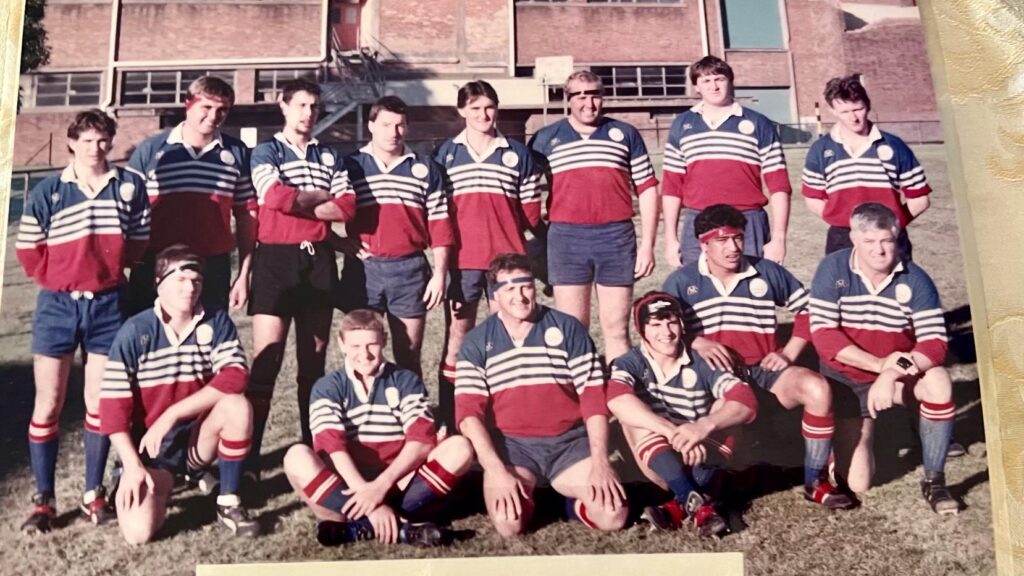
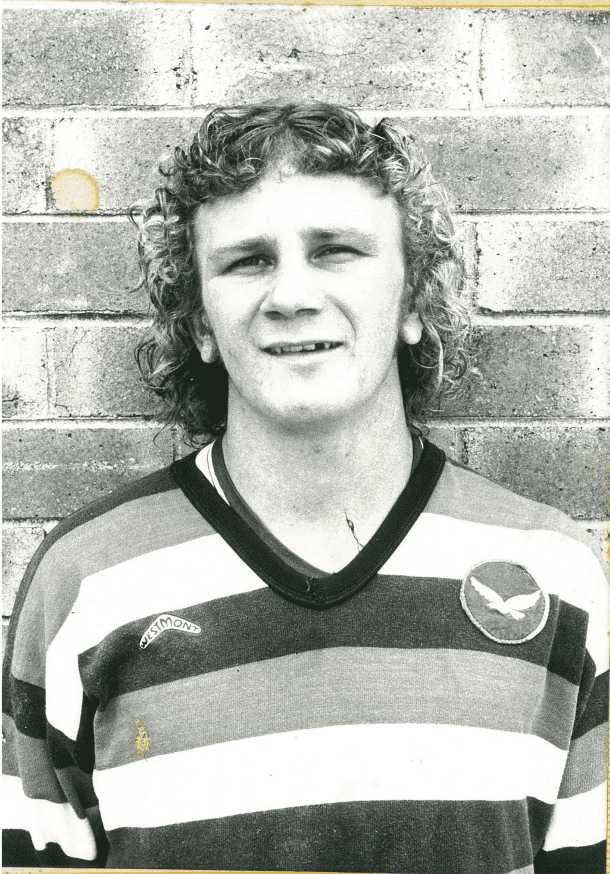
10) A Litte Resurgence – 1980’s
In the late 1970’s and early 1980’s an additional team joined the NRU (div 1) competition, Hamilton (Hawks). The other existing teams were Port Hunter, Wanderers, Merewether-Carlton, University, Mayfield East, Maitland, Boolaroo, Waratahs. 1980 saw Medowie (4th grade) separate from Port Hunter to join the NRU (2nd div) competition. However, another junior club developed in 1979 in the former Lemontree Passage/Tanilba Bay calling itself the Tilligerry Tigers and took Medowie’s place. By affiliating with Port Hunter.
In late 1979 a senior club from Tilligerry Tigers also affiliated and became our 4th grade side.
1980
1st grade coach – Bill Van Rugge
Kevin Jackson made a life member
3rd grade (Nelson Bay) lost semi-final
Tilligerry Tigers (U/10’s) – Won grand final
Tilligerry Tigers (U/12’s) – Lost final
1981
Port Hunter began to feel the impact and strengthening of our club. Several players from Nelson Bay and Tilligerry became regular 1st grade players and the 4th grade team were undefeated minor and major premiers to win the first lower grade grand final since the reserve grade side of 1964.
1st grade coach – Ross Allen
Ken Grainger – 100 1st grade games
-
Lee NSW U/10
4th grade – Port Hunter (Tilligerry Tigers)
Undefeated minor and major premiers (Coach Dave Seroff)
1982
1st grade coach – Ross Allen
Peter Bland and Peter Matthews – Life members.
1983
1st grade Coach – Brian Rudder.
Doug Terry – 100 Games played
Brian Rudder – Life member
1984
1st grade coach – Reg Perini
Reg Terry and Roy Gorst – Life members
1985
1st grade coach – Reg Perini
Mrs. Merab Terry and Stuart Trench – Life members.
1986
1st grade coach – John Bevan
Greg Carrigan – 100 1st grade games.
-Mick Reid and Warren Badger – NSW Country (CHS)
1987
1st grade coach – John Bevan
Mark Carpenter – 100 1st grade games
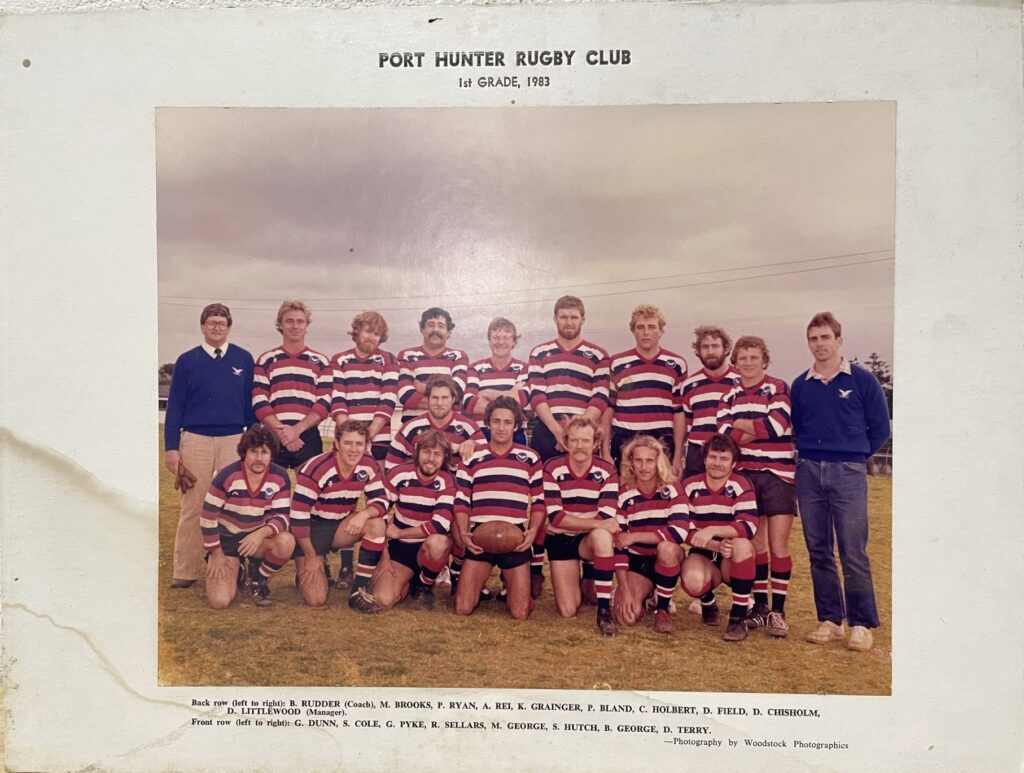


Stockton “Stuffed Seagulls” Golden Oldies
For several years from 1987 to the early 1990’s the club had a Golden Oldies team that played against the teams in NSW and in 1987 went to the world Golden Oldies championship in Auckland. The rules of the Golden Oldies competition are as follows:
-
Players must be 35 years of age or older
-
Games are 3 x 20-minute periods or as determined by mutual agreement.
-
All 8 forwards must remain bound in the scrum until at least the ball is cleared.
The spirit of “Golden Oldies” epitomised in the motto of “Fun, Friendship, and Fraternity.”
The international motto is the central theme of every Golden Oldies game. The normal laws of the IRB shall apply with the following law variation (Unless varied by the mutual agreement between teams and officials).
-
The halfback must not follow the ball around the scrum.
-
There shall be no pressure scrummaging or striking against the head by the hookers.
Coloured shorts:
All players are to observe the restrictions on tackling “older” players. The restrictions are identified by coloured shorts.
Up to 59 years: Club Shorts
60 to 64 years: Red Shorts *Can be claimed but not to be tackled
65 to 69 years: Gold Shorts* Not to be tackled
70 to 84 years: Purple *Not to be tackled
85 years +: Special * Will be provided by the club, not to be tackled
**Any player who through medical or physical condition does not warrant to be tackled.
NZ Tour May 1987 – Auckland
The following 14 old members of Stockton Rugby Club plus 2 other old members (1 each from Mayfield East and the Waratahs) plus 2 x wives attended and played 3 games at the Auckland Golden Oldies carnival.
The team is listed below:
Brian Rudder: Organiser/Manager
Bill (Billie) Grey – Over 70 (Mayfield East)
Roy Gorst (Over 60)
John (Bevo) Bevan
John Brown (The Waratahs)
Trevor Bates
Don (Doc) Bland
David Billett
Noel (Oddjob) Burns
Carl Cox
Bruce Evans
Des Warren (the spoon man)
Roger Forward
David (Daffy) Gray
Note: To play with a full team of 15 we co-opted additional players from the teams we played.
*Two of the two wives Effie Bland & Trish Grey were our cheer squad.
The Stuffed Seagulls played 5 games against:
Ancient Mariners (Ex NZ Navy)
Loopey Lupis (Counties NZ)
Teachers Eastern “Troopers” from Auckland.
“Lunchtime Legends” a combined team from NSW Rugby Club Ltd & Holbourn Uni RFC.
NZ Invisibles a team of all ex-All Blacks in the main game at North Harbour Stadium. What an honour from a team from Stockton.
Attached are photos of the plaques presented by the “Troopers” and “Lunchtime Legends” (The NZ Invincibles didn’t present plaques to any team).
The game against the “NZ Invincibles” was noteworthy for the wrong reason.
One of their players was over 85 and consequently couldn’t be tackled. However, in a previous game we played, an opposing player fell to the ground in front of Billie Grey (our over-70 player) and luckily Billie was agile enough to jump over him. It was a great laugh for all.
In our game against “NZ Invincibles,” Noel Burns thought it would be a good idea to do the same, lay in front of their over 85 player. Wrong. The ‘Old Bloke’ wasn’t agile enough to jump over Noel and tripped over him and fell. There was an uproar from everywhere, players, referee, spectators, etc. Until the “old bloke” eventually got up and swore at Noel and slapped him a few times. At one moment we thought we may have to run for it to stop being lynched. That was Noel to a tee (Ha, Ha).
The trip of 6/7 days was an outstanding success, and everyone had a great time. Many thanks also must go to “Mr. Organiser” Brian Rudder who organised and managed the trip.


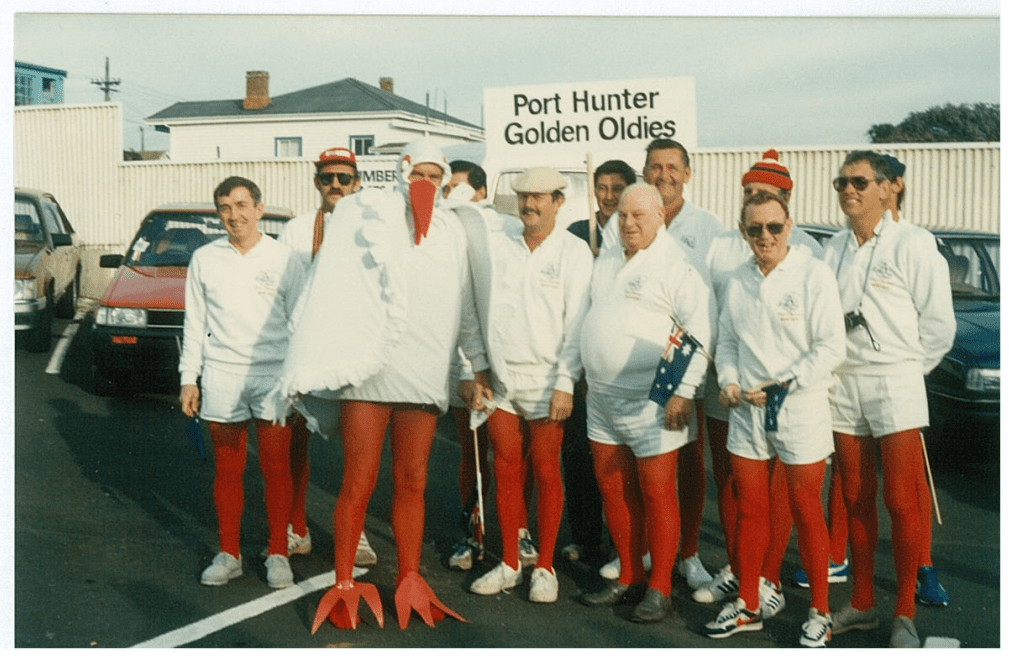
“What a wonderful time we all had”
By – John (Bevo) Bevan.
Port Hunter Win – NRU Bi-Centennial 7 a Side Championships May 1988
Port Hunter won the NRU Bi-Centennial 7 a side competition on 22nd May 1988.
The team scored 114 points overall, and had only 28 scored against it over the weekend. They easily beat the Waratahs 26–8 in the final, after beating University 26–4, Boolaroo 36–6, and Maitland 28–10 in the preliminary games.
Best for Port Hunter were centre Doug Reid who scored the most tries over the competition. Scoring 3 in the final and forward Simon Brodie. Hamilton won the plate final over Wanderers 22–8.
The full team was: -Mark Carpenter (Capt), Grant Stewart, Ken Cooper, Simon Brodie, Mick Reid, Doug Reid, Roy Stevens, Dick Harris, Jason Gray, David Haddock.
Co-Coaches – John Bevan (1st grade Coach) and Ken Grainger. (Ken coached the team over the weekend as Bevo had to work at Newcastle Hotel over the weekend). Ken’s game plan was to ‘go for it’ and it definitely worked.
Naturally, Bevo’s Newcastle Hotel had a great party after the game and rocked, more than usual. The after-game party went into the early hours – what’s new !!
We Are The Champions – not of the world though.
1988
1st grade coach – John Bevan
7 a Side Bi-Centennial – Co- Coaches – John Bevan and Ken Grainger.
Note -Won NRU 7 a Side Bi-Centennial Carnival.
1989
1st grade coach – Peter McNamara
Inness Creighton – Life Member
1990
1st grade coach- Peter McNamara
Paul Ryan – 100 1st grade games
Michael Reid– NSW Country (v-City) NSW U/21’s – 1st Anderson Medal (NRU Best and Fairest), 1st Ray Woolf Medal (NRU Award)
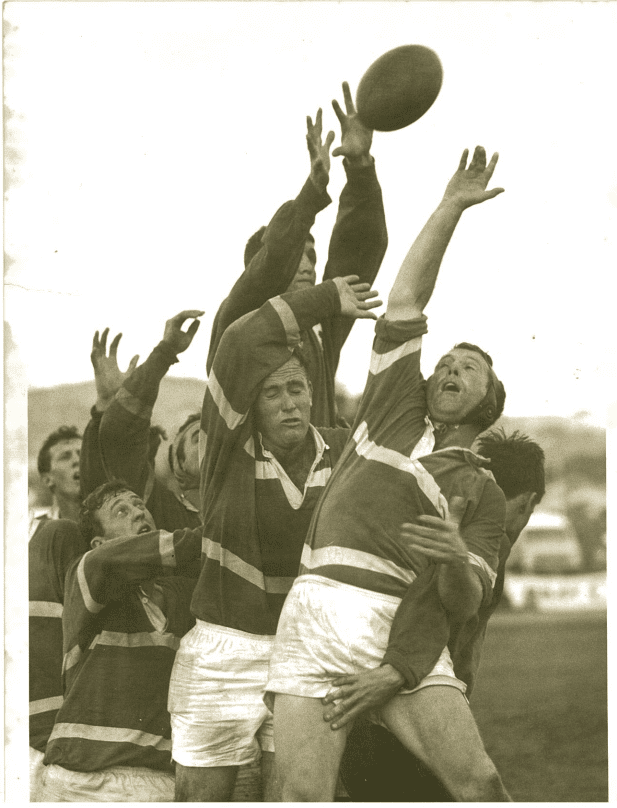

11) Formation of Tech Port – Amalgamation with Tech College
Amalgamation with Technical College (2nd div) Club and Formation of Tech Port (Griffins) (1st div) Rugby Union Club – 1991 to 1996.
Once again due to poor results, attempts to revitalise interest in the club. Port Hunter and Technical College (Griffins) Rugby Club decided to amalgamate and form Tech Port Griffins (1st div) Rugby Club in late 1990 and play in the 1991 season.
1991
1st grade coach Tech Port (Griffins) – Peter McNamara
Michael Reid – NSW Country v City – NSW U/21s.
1992 to 1996 – No Records available currently of 1st grade coach or any life members or rep players etc for Tech Port (Griffins). *Due to a lack of players and other major reasons Tech Port (Griffins) (1st Div) Rugby Club folded at the end of the 1996 season.
1993- Doug Terry played 200 1st-grade games (for Stockton, Port Hunter, and Tech Port Clubs). The probability his overall total of games for all clubs would be more than 350. He continued to play for Newcastle Griffins 2nd div) until 1999.
Doug Terry – Life Member
12) STOCKTON SCHOONERS 1997 – 2000
1997 – Was a big year for our club because two new clubs were formed and both played in the NRU (2nd div) competitions. The first – Stockton (Schooners) Rugby Club – was formed after a meeting of the following players of Stockton/Port Hunter 1st div club in early 1997: Ken Grainger, Ross Boyd, Peter Quinn, Peter McNamara, Peter Anderson, Snags Stokes, Roy Gorst and Ian Cartwright. Most of the above names made up the committee for the 4 years to 2000 with: Ken Grainger as president, Ross Boyd as secretary,
Peter Quinn – Coach, Peter Anderson – Treasurer, John Bevan – Patron.
The club played in the NRU 2nd Division – Patrons Shield Competition from 1997 to 2000.
1999 – Lost final
2000 – Undefeated minor and major premiers. Didn’t play in 2001, suppose they thought they had won and winners are grinners. Achieved everything they wanted to.
Below is a list of players who played over the 3 years (with apologies for any omissions or errors):
Keith Wagner, John Molloy, Mick (Toot) Molloy, Damien Grant, Cabel McCauley, Tony Capponecchia, Mark Freeman, Brett Smith, Shane Holbrow, Grant Duff, Allan Lancaster, Michael Prentice, Craig Prentice, Brendon Slade, Kahu Patuwa, Jorgan Hallman, Wally (Phillips ?), Aaron Craig, Josh ?, Guy Wilson, Justin Wilson, Jason Gray, David Haddock, Sterling Anderson, Jose Faultaufon, Shane Price, Mark O’Rourke,Radley Merza, Taho Patuwa, Matt Sinclair, David Mehan.
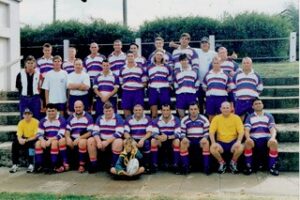

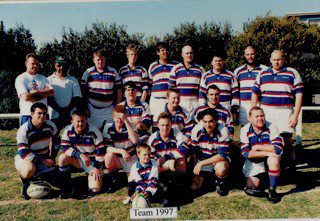
13) Newcastle Griffins – The Future
In 1991, the NHRU criteria meant fielding four (4) teams to stay in the premier division of the day.
Our club numbers were down at this stage and it was not possible to muster four (4) competitive sides. Talks were held and a merger was formed with the Tech College Club to form what was known as Tech-Port Rugby Club.
Both clubs boast proud histories, the Tech College Rugby Club was formed in 1948.
The merger was relatively successful and enjoyed some memorable wins against a number of the big teams of the day, however, a premiership evaded us.
The introduction of the Newcastle Wildfires (whilst a positive move for the region) did deplete our quality player stock including Marty Lisuia, Tony Davis, Todd Lawrence, James McLachlan and Warren Badger to name a few.
In the late 90’s the club decided to revert back to two (2) teams, in what is now known as the ‘Divisional competition’, changing the name to the ‘Newcastle Griffins’.
The Griffin symbol holds significance. This fearsome mythological beast brings together the head and wings of an eagle and the body of a lion.
Port Hunter being Seagulls, and the Tech College being Tigers, so Seagull and Tiger are extremely close to an Eagle and a Lion.
In 2019, Newcastle Griffins made the bold move to relocate the club west of Newcastle to fill a Rugby void in the area. From there, they have established a Junior Club and together the Juniors and Seniors look towards many seasons of growth as the ‘West Newcastle Griffins’. The Senior 1st XV team was runners-up in the 2022 Grand Final.
Griffins First XV Coaches:
1991 – Peter McNamara
1992 – Peter McNamara
1993 – Rob McLachlan
1994 – Rob McLachlan
1995 – Justin McMillan
1996 – Justin McMillan
1997 – Paul Ryan
1998 – Paul Ryan
1999 – Paul Ryan
2000 – Paul Ryan
2001 – Trevor Bates
2002 – Trevor Bates
2003 – Darren Forbes
2004 – Michael Sager
2005 – Michael Sager
2006 – Michael Sager
14) List of Major Office Bearers
Stockton / Port Hunter Rugby Club Major Office Bearers
Year |
President |
Secretary |
Treasurer |
Stockton reserves only |
|||
1886 |
No records found |
Not known (Juniors only) |
|
1895 |
R.Lynn |
No Records found |
|
1896 |
R.Lynn |
Not Known |
|
Stockton United |
|||
1901 |
W Towers |
||
1902 |
W Towers |
No Records found |
|
1903 |
W Towers |
||
Stockton Wanderers |
|||
1902 – 1904 |
No Records Found |
||
1905 |
Abraham |
No Records found – Not Known |
|
1906 |
Stanley Hudson |
||
Eastern Districts |
|||
1907 – 1915 |
No Records found |
||
1916 – 1923 |
Competition not played due to World War 1 |
||
Port Hunter |
|||
1924 – 1930 |
No Records found – Not Known |
||
1931 |
V.G.Hodges |
James Tobin |
Eric Bensen |
1932 |
V.G.Hodges |
J.Bessell |
J.Nourke |
1933 |
W.Fisher |
James Tobin |
Eric Bensen |
1934 |
No Records found – Unknown |
||
1935 |
No Teams Entered |
||
1936 |
No Teams Entered |
||
1937 – 1940 |
No Teams Entered |
||
1941 |
M.Johnson |
O.Dickson |
Not Known |
1942 |
M.Johnson |
O.Dickson |
|
1943 |
M.Johnson |
O.Dickson |
|
1944 – 1958 |
No Teams Entered |
||
Stockton |
|||
1959 |
W (Bill) Davies |
Russell Stokes |
Ron Eaton |
1960 |
Bill Davies |
Russell Stokes |
Ron Eaton |
1961 |
Bill Davies |
Russell Stokes |
Ron Eaton |
1962 |
Bill Davies |
Russell Stokes |
Bruce Stokes |
1963 |
Bill Jackson |
Reg Stokes |
Bruce Stokes |
1964 |
Bill Jackson |
Reg Stokes |
Bill Robson |
1965 |
Bill Jackson |
Reg Stokes |
Bill Robson |
1966 |
Bill Jackson |
Reg Stokes |
Bill Robson |
1967 |
Bill Jackson |
Reg Stokes |
Bill Robson |
1968 |
Bill Jackson |
Reg Stokes |
Bill Robson |
1969 |
Bill Jackson |
Reg Stokes |
Bill Robson |
1970 |
Bill Jackson |
Reg Stokes |
Bill Robson |
1971 |
Ian Constable |
Brian Rudder |
|
1972 |
Ian Constable |
Brian Rudder |
|
1973 |
Ian Constable |
Brian Rudder |
Stuart Trench |
1974 |
Ian Constable |
||
Port Hunter |
|||
1975 |
Ian Constable |
||
1976 |
Ian Constable |
||
1977 |
Brian Rudder |
||
1978 |
Brian Rudder |
||
1979 |
Brian Rudder |
||
1980 |
Brian Rudder |
Merab Terry (MRS) |
|
1981 |
Brian Rudder |
||
1982 |
Brian Rudder |
||
1983 |
Innes Creighton |
||
1984 |
Innes Creighton |
||
1985 |
Innes Creighton |
||
1986 |
Innes Creighton |
||
1987 |
|||
1988 |
|||
1989 |
|||
1990 |
|||
Tech – Port |
Amalgamated with Tech College |
||
1991 |
Innes Creighton |
Merab Terry (MRS) |
Stuart Trench |
1992 |
Innes Creighton |
Merab Terry (MRS) |
Stuart Trench |
1993 |
Innes Creighton |
Merab Terry (MRS) |
Stuart Trench |
1994 |
Innes Creighton |
Merab Terry (MRS) |
Stuart Trench |
1995 |
Innes Creighton |
Merab Terry (MRS) |
Stuart Trench |
1996 |
Innes Creighton |
Merab Terry (MRS) |
Stuart Trench |
1997 (Stockton Schooners) – 2nd Div |
Ken Grainger |
Ross Boyd |
Peter Anderson |
1998 |
Ken Grainger |
Ross Boyd |
Peter Anderson |
1999 |
Ken Grainger |
Ross Boyd |
Peter Anderson |
2000 |
Ken Grainger |
Ross Boyd |
Peter Anderson |
Newcastle Griffins – 2ndDiv |
|||
1997 |
TBC |
||
TBC |
|||
TBC |
|||
TBC |
|||
2022 |
TBC |
15) Life Members- including Life Members of Newcastle Rugby Union (NRU)
1969 – Reg W Stokes – Stockton
1970 – William (Bill) Robson – Stockton
1971 – Jack Dennis – Stockton
1973 – Jack Day – Stockton
1973 – Keith Mahaffey – Stockton
1980 – Kevin Jackson – Stockton
1984 – Reg Terry – Port Hunter
1984 – Brian Rudder – Port Hunter
1984 – Roy Gorst – Port Hunter
1984 – (Mrs) Merab Terry – Port Hunter
1985 – Stuart Trench – Port Hunter
1989 – Innes Creighton – Port Hunter
1993 – Doug Terry – Port Hunter / Tech College
2019 – Gareth Terry – Newcastle Griffins
Newcastle and Hunter Rugby Union
1973 – Bill Robson (Juniors)
1973 – Bill Robson (Seniors)
2018 – Brian Rudder
16) Major Representative Honours, including Other Major (NRU) Honours
1st Grade – NSW Country – NSW – Australia
1963 – Bob Cox (v-City)
1964 – Ernie Worrell (v-city)
1965 – John Bevan (v-city) U/21’s
1966 – John Bevan (v-City) and (v-QLD Country)
1966 – Ken Knight (Northern NSW – N2 Town)
1967 – John Bevan (v-city) (NZ Tour), (NSW – v – Qld * Suspended and couldn’t play)
1967- Peter McNamara (v-city)
1968 – Peter McNamara (v-city)
1969 – Peter McNamara (v-city)
1979 – Peter Bland (v-city)
1990 – Mick Reid (v-city), (NSW U/21’s)
1991 – Mick Reid (v-city), (NSW U/21’s)
Note – The following players are represented while playing with other clubs.
1950 to 1957 – Jack Dennis – Combined Services (RAAF).
1950’s – Jack Dennis – Northern Malaysia – Malaysia (HONG KONG Tour)
1950’s – Dr. John Bromley – Australia / NSW (Sydney University)
1972 – Barry Moon – QLD (Western Suburbs, Brisbane)
Early 1980’s – Peters Matthews – NSW Country (Mayfield East)
Late 1980’s – Jason Gray – NSW Country (Mayfield East)
1991/1992 – Alan Barker – Coach – NSW Country
Juniors.
1962 – Robert Haynes – NSW U/18’s.
1962 – John Bevan, Terry Davies – NSW Country U/16’s
1963 – John Bevan, Terry Davies, – NSW Country U/18’s
1964 – Terry Davies (Capt), John Bevan – Aust U/18’s (v-rep), Kevin Jackson
1964 – Terry Davies (Capt), John Bevan, Kevin Jackson, Mick Hunt, Lindsay Gailey, Paul Corbett, NSW U/18’s.
Note – NSW Selected two sides, NSW (City) and NSW (Country) for the Australian championship carnival. (NSW Country won the carnival beating NSW City in the final).
1964 – T Davies (Capt) J. Bevan, K.Jackson, M.Hunt, L.Gailey, P.Corbett (NSW Country U/18’s).
1966 – Larry Maher (C), Gary Balcolmb, NSW Country U/18’s
1968 – Geoff Hickey – NSW Country U/18’s
1976 – Doug Terry – NSW (CHS)
1976 – Doug Terry – NSW Country U/18’s
1981 – A.Lee – NSW U/10’s
1985 – Jason Gray, Warren Badger – NSW Country U/18’s
1986 – Mick Reid, Warren Badger- NSW Country (CHS)
Note: 1960 – George Thompson – NSW U/14’s (Maitland)
Other Major Newcastle Rugby Union Honours:
1961 – Reg Terry – 2nd Anderson Medal (Best and Fairest)
1971 – Peter McNamara – 1st Anderson medal (Best and Fairest)
1975 – Brian Griffiths – 2nd Anderson Medal (Best Fairest)
1976 – N.Skillen – 1st Ray Woolf Medal
1990 – Mick Reid – 1st Ray Woolf Medal
1990 – Mick Reid – 1st Anderson Medal (Best and Fairest)
Newcastle Grade (1st Division) Representative Honours
No records could be found for years before 1932. So the list below starts then (Apologies for any omissions).
1932 – W.Tobin, T.Bland (-v-All Blacks) H.Williams, C.Elferson (v-Aust Navy) N.Nalder (Newcastle 2nd’s)
Note: – 8 Players – V.Brady, H.Williams, T.Bland, Boyd, J.Dumbell, C.Elferson, W.Tobin, N.Nalder were selected in the Newcastle Possibles -v-Probables came to select the Newcastle side. The players above were successfully selected as listed.
1934 -H.Henderson, T.Davies
1941 – Terry Belcher
1959 – Don Terry, Ross Wilson
1960 – Jack Dennis, C.Lacey, K.Kerr
1961 – Reg Terry (v-Fiji)
1962 – Reg Terry, Bob Cox, Ken Knight
1963 – Bob Cox, Ken Knight, Reg Terry, John Davis, Neil Brough, (v-Gordon and Country championships).
1964 – K.Kerr, Ernie Worrell, John Davis
1965 – John Bevan- (V-Auckland grammar and South Otago, U/19’s)
1966 – John Bevan, Peter McNamara, Ken Knight.
Terry Maher, Terry Davies, Brian Griffiths – U/23’s.
1967 – John Bevan, Peter McNamara, Ken Knight
1968 – Peter McNamara, John Hor
1969 – Peter McNamara, Mick Hunt
1973 – Peter Bland, Bill Stibbard – U/19’s (v-Aust navy and v- QLD U/19’s).
1974 – Stuart Trench, Brian Griffiths.
1974 – Peter Bland, Peter Matthews, Peter Wright, D.Mathieson, (Newcastle 21’s)
1978 – Peter Bland
1979 – Peter Bland, Peter Wright, Peter Matthews.
1981 – Peter Wright, Ken Howard, Peter Matthews.
Rick Baker, Geoff Pyke, John Anderson (Newcastle U/21’s).
1985 – Mick Reid, Jason Gray, (V-U/21’s Italy) *While playing U/18’s
1986 – Mick Reid, Simon Brodie, Warren Badger, Ken Cooper, Grant Stewart (U/21’s).
1986 – Mick Reid, Ken Cooper (U/21’s – USA Tour)
1988 – Mick Reid
1989 – Mick Reid
1990 – Mick Reid
1991 – Mick Reid – (USA/UK Tour)
1991 – Innes Creighton – Asst manager (USA/UK Tour)
2006 – 2008: Alan Barker-Newcastle Coach – (From another club)
Note: In 1986 the NRU selected a squad to train on for the Newcastle U/21 teams. Port Hunter had 15 players selected and those listed above in the two teams were selected:
Those selected to train on were:
M.Reid, K.Cooper, S.Brodie, W.Badger, Y.Stewart, T.Channon, J.James, J.James, P.Frazer, D.Haddock, M.Rodgers, M.Smith, D.Edwards, C.Hollbert, B.Searle.
Newcastle Junior Representative Honours
1960’s – U/16’s John Davis, Jeff Dawson, Neil Brough, Bill Kociuba.
U/14’s John Bevan, Ken Darby, Ross Boyd, Kevin Jackson, Doug Jackson, Greg Jackson.
1961 – U/18’s John Davis, Neil Brough, McMurray, Robert Haynes, Terry Maher.
U/16’s John Bevan, Jeff Groves, Mick Hunt, Terry Davies, Richard Rankin.
1962 – U/18’s John Davis, Neil Brough, Robert Haynes, Terry Maher, Doug Brady, Brady G Garland.
U/16’s John Bevan, Terry Davies, M.Hunt, Kevin Jackson.
1963 – U/14’s Mick Davis, Larry Maher, David Parker, Clive Horan, Fred Jones, Gary Jones, Ray Davis, Phil Thoroughgood.
U/16’s John Bevan, Terry Davies, Mick Hunt, Kevin Jackson.
1964 – U/18s John Bevan, Terry Davies, Mick Hunt, Kevin Jackson, Terry Johnson, Lindsay Gailey, Paul Corbett, Warren House (-v- Sydney)
U/18’s John Bevan, Terry Davies, Mick Hunt, Ken Dalby, Kevin Jackson, Lindsay Gailey, Paul Corbett (v-Country Week).
U/16’s Larry Maher, Greg Jackson, David Parker, Fred Jones, Ray Davis.
U/14’s G.Jones, G.Davis, T.Davies, S.Shearman, John Truscott, John Chalmers.
1965- U/16’s Larry Maher, Mick Davies, Terry Armstrong, R.Davis, John Truscott, David Parker, Graham George.
U/14s T.Davies, G.Davis, Stephen Bland, Geoff Hickey, R.Arncliffe, S.Shearman, Greg Jones.
1966- U/18’s Larry Maher, Gary Balcomb, Alan Sutton, Owen Jeans, Mick Davis, Graham George.
The same Six players played against the NZ Touring Side.
1967- U/16’s Stephen Bland, Geoff Hickey, S.Shearman, Paul Young.
1967- U/14’s David Kay
1968- U/18’s Geoff Hickey, John Truscott
1976- U/18’s Doug Terry
1981- U/10’s A.Lee
1986- U/18’s Jason Gray, Warren Badger
1987- U/18’s Mick Reid
1988- U/18’s Mick Reid
17) List of 1st Grade Coaches
1st Grade coaches (from 1932 only and 1959 to 2022)
Note: (1) No records were found before 1959 except for 1932.
(2) *Denotes 2nd div team
(3) Christian name of “Pommy” White is not known
(4) Starting his coaching career Jack Dennis was transferred away from Williamtown RAAF Base for several long periods.
1932 – C. O’Brien. – Port Hunter
1959 – “Pommy” White – Stockton
1960 – Jack Dennis – Stockton
1961 – Bruce Stokes – Stockton
1962 – Reg Stokes – Stockton
1963 – Jack Dennis – Stockton
1964 – Jack Dennis – Stockton
1965 – Jack Dennis – Stockton
1966 – Jack Dennis – Stockton
1967 – Jack Dennis – Stockton
1968 – Jack Dennis – Stockton
1969 – Jack Dennis – Stockton
1970 – Jack Dennis – Stockton
1971 – Jack Dennis – Stockton
1972 – Jack Dennis – Stockton
1973 – Jack Dennis – Stockton
1974 – Jack Dennis – Stockton
1975 – Jack Dennis – Port Hunter
1976 – Greg Stewart – Port Hunter (8 Weeks only after players coached themselves to the end of the season).
1977 – Ken Grainger – Port Hunter
1978 – Ken Grainger – Port Hunter
1979 – Bill Van Rugge – Port Hunter
1980 – Bill Van Rugge – Port Hunter
1981 – Ross Allen – Port Hunter
1982 – Ross Allen – Port Hunter
1983 – Brian Rudder – Port Hunter
1984 – Reg Perini – Port Hunter
1985 – Reg Perini – Port Hunter
1986 – John Bevan – Port Hunter
1987 – John Bevan – Port Hunter
1988 – John Bevan and Ken Grainger – Port Hunter (7aSide)
1989 – Peter McNamara – Port Hunter
1990 – Peter McNamara – Port Hunter
1991 – Peter McNamara – Tech Port
1992 – 1996 (TBC) – Tech Port
1997 – Peter Quinn – Stockton Schooners (2nd Div)
1998 – Peter Quinn – Stockton Schooners (2nd Div)
1999 – Peter Quinn – Stockton Schooners (2nd Div)
2000 – Peter Quinn – Stockton Schooners (2nd Div)
2001 – 2023 (TBC) – Newcastle Griffins (2nd Div)
18) List of Players who have played 100 (or more) 1st Grade Games
1965 – Robert (Bob) Cox*
1966 – Ken Knight
1967 – Jack Dennis* (Overall 305+ Games, 100+ Stockton, 98 tech College, 92 RAAF, 15 Canberra)
1967 – Ross Wilson*
1971 – Peter McNamara*
1975 – Alan Sutton
1978 – Noel Burns
1981 – Ken Grainger
1982 – Stuart Trench*
1982 – Peter Matthews
1982 – Peter Bland *
1983 – Doug Terry (100)
1986 – Greg Corrigan
1987 – Mark Carpenter
1990 – Paul Ryan
1993 – Doug Terry (200) – (Overall 300 to 350 games estimate 300 1st grade. – Played with Tech Port and Newcastle Griffins until 1999 (2nd Div) (Total of 24 Years)
2019 – Garth Terry (Newcastle Griffins)
Note; The authors believe there would have been members and players who were awarded life membership and played 100 (1st Grade) games and 100 (Junior / Senior) grade games for our club before 1959 when the list started. However, due to the lack of records etc, their names are not listed. – Apologies.
19) List of Players who have played 100 (or more) games (Juniors &/or Grade)
Note: (1) Due to the lack of records when Jeff Brady completed his 50th year history from 1952 to 1982, he decided not to try to complete this list.
(2) However, to the best of my ability after talking to many ex-players and supporters. I have completed the list below.
(3) Apologies for any omissions or errors made.
(4) Those players already honoured for playing 100 games (or more) 1st grade games for the club have not been included on this list.
(5) I have tried to list the players in chronological order to the best of my ability, in the decade they first started playing.
1959 to 1969
Bruce Stokes, Russell Stokes, Reg Stokes, Reg Terry, Roy Gorst, C.Lacey, K.Kerr, Ernie Worrell, Mick Matthews, Roger Forward, Jimmy Newton, Jeff Brady, Barry Martin, Robert Johnson, Neil Brough, John Davis, Robert Haynes, David Pont, Terry Maher, Dennis Maund, John Gresham, Don Felsh, David Dives, Peter Frazer, David Hunt, John Hunt, Mike Hunt, John Bevan, Terry Davies, Ross Boyd, John Boyd, George Thompson, Col Bradford, Paul Corbett, Steve O’Neill, Brian Griffiths, Les Clive Horan, Gary Balcomb, Charlie Belcher, Charlie Moffett, Roger Stretton, Larry Maher, Graham George, Brian Leary, Bruce Evans, John Lashwood, Noel Maher, Brian Rudder, Carl Cox, Alan Barker, Owen Jeans, John Kirsopp, Keith Wagner, Geoff Rolston, David Hayman, Phil Thorogood, John Truscott, Ted Delbridge, John Molloy, Mick Molloy, Brett Smith, David Murray.
1970’s
Stuart Trench, Trevor Bates, Mark Freeman, Jordan Hallman, Guy Wilson, John Anderson, Greg Jones, Ian Cartwright, Gary Cox, Peter Wilkinson, Rod Sellers, Peter Llowarch, Mark Cole, Steve Gill, Stephen Keddie, Steve Newell, Wayne Brownlowe, Kevin Armstrong, Ron Hinchcliffe, Robert Stephen, Wayne Mason.
1980’s TBD
1990’s
David Haddock, Todd Trench, Ken Cooper
2000’s TBD
John Bevan
20) Grand Finals, Finals & Semi Finals and other championships played
1907 – East Newcastle (4th grade) – Major Premiers
1912 – East Newcastle (2nd Grade) – Major Premiers
1915 – East Newcastle (1st Grade) – Co-Premiers (with East End/Maitland) Drew 1st final 6 – 6,
not replayed due to WW1.
1932 – Port Hunter (Lost Semi)
1933 – Port Hunter (2nd Grade) – Major Premiers
1959 – Stockton (1st Grade) – Lost Alderton Cup Final
1960 – Stockton (U/14’s lost grand final) (U/16’s-Minor premiers – Lost GF)
1961 – Stockton (U/14’s, U/16’s, U/18’s, All Lost grand finals (But won junior club championship)
1962 – Stockton (U/18’s) – Lost Final
1962 – Stockton (U/16’s) – Undefeated minor premiers – Lost Grand Final
1962 – Stockton (2nd grade) – Lost Final
1963 – Stockton (U/18’s, U/16’s) – Lost Final. U/14’s – Major Premiers
1964 – Stockton (1st grade) – Lost Semi. U/18’s Undefeated Minor Premiers- Lost GF 6 – 5.
1964 – Stockton (2nd grade) won the grand final (14 – 12). Stockton (U/14’s) – Won Grand Final.
1964 – Stockton (U/16’s) – Lost Final. (U/12’s Minor and Major Premiers).
1965 – Stockton (1st Grade) – Lost Semi (in 2nd replay after drawing with Merewether Carlton in the first two games)
1965 – Stockton (U/18’s) – Lost Grand Final (After drawing 1st game). (U/16’s major Premiers)
1965 – Stockton (U/14’s) – Undefeated minor and major premiers.
1965 – Stockton (Junior and seniors) won the Presidents Cup point score.
1966 – Stockton (U/18’s) – Lost final
1968 – Stockton (1st grade) lost the Grand Final (9-3).
1969 – Stockton (1st grade) Undefeated minor premiers – Lost grand final (14 – 13)
1969 – Stockton (3rd Grade) – Lost Semi. (4th Grade) – Lost Semi
1978 – Port Hunter (Nelson Bay) 3rd grade – Lost Semi
1978 – Port Hunter (Medowie) 4th Grade – Lost Semi
1979 – Port Hunter (Nelson Bay) 3rd grade – Lost Semi.
1979 – Port Hunter (Medowie) 4th Grade – Lost Semi
1980 – Port Hunter (Nelson Bay) 3rd grade – Lost Semi
1980 – Port Hunter (Tilligerry Tigers) U/12’s Lost Semi
1980 – Port Hunter (Tilligerry Tigers) U/10’s Major Premiers
1980 – Port Hunter (Tilligerry Tigers) 4th Grade – Undefeated minor and major premiers.
1981 – Port Hunter (Tilligerry Tigers) – U/12’s and U/10’s Majors Premiers.
1981 – Port Hunter (Nelson Bay) – U/14’s – Major Premiers
1988 – Port Hunter (1st grade 7 a side) Won – NRU Bi–Centennial 7aside championship carnival.
1999 – Stockton Schooners (2nd Div) – Lost Final
2000 – Stockton Schooners (2nd Div) – Undefeated minor and major premiers “Patrons Shield”.
2006 – Newcastle Griffins (2nd Div) – Lost Grand Final
2012 – Newcastle Griffins (2nd Div) – Lost Grand Final
2022 – Newcastle Griffins (2nd Div) – Lost Grand Final (27 – 26)
21) Team of the Century
Fullback – Reg Terry (1960’s)
Wings – Neil Brough (1960’s) – John Hor (1960’s/1970’s)
Centres – John Blomley (1960’s) – Ken Knight (1960’s)
Five-Eighth – Brian Griffiths (1960’s / 1970’s)
Halfback – M.Reid (1980’s / 1990’s)
Lock – Peter McNamara (1960’s/1970’s)
Breakaways – Bob Cox (1960’s) – John Bevan (1960’s)
2nd Row – Ernie Worrell (1960’s) – Peter Bland (1970’s/1980’s)
Hooker – John Kearns (1960’s)
Front Row – Jack Dennis (*Captain) (1960s) – Mick Hunt (1960’s/70’s)
Reserves – (Backs) Don Terry, John Davis (Both 1960’s), Kevin Jackson, Mick Davis (Both 1960’s/70’s),
Jason Gray (1980’s/90’s/00’s), Ken Cooper, Doug Reid (1980’s/90’s).
Forwards- Ross Wilson, Robert Haynes, Barry Moon (1960’s), Terry Davies (1960’s/70’s), Alan Sutton(1970/80’s)
Stuart Trench (1960’s to 1980’s), Peter Matthews (1970’s/80’s), Doug Terry (1970’s to 1999).
“As selected by Peter McNamara and John Bevan”
Note:
(1) Reg and Don Terry are brothers and Doug is Reg’s Son.
(2) Doug and Mick Reid are Brothers.
(3) Ken Cooper came from the Nelson Bay amalgamation
22) Best Players & Junior Teams
1st Grade Team – 1969 Grand Final
The team were undefeated minor premiers only to lose the grand final – 14/13 by Maitland.
Front Row – Mick Hunt – Ray Hamilton
Hooker – Brian Leary
2nd row – Terry Davies (c) – Robert Haynes
Breakaways – Gary Balcombe – Barry Moon
Lock – Peter Macnamara
Half Back – John Lashwood
5/8th – Mick Davis
Centres – John Bowie –David Cooper
Wings – Grahame George – Allan Gwynne
Fullback – Roger Stretton
Reserves – Clive Horan, Larry Maher, Ted Delbridge, Alan Sutton, John Hor.
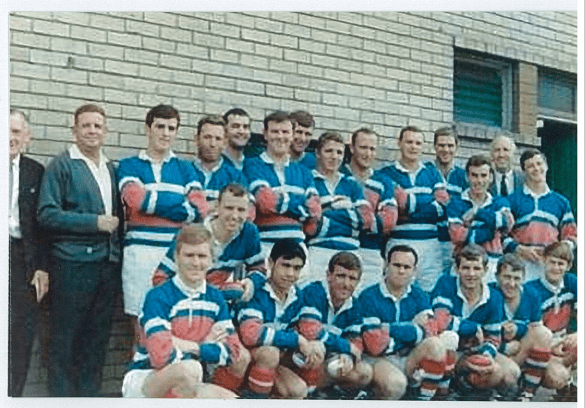
1968 Grand Final Team
U/18’s Junior Team – 1964 Grand Final
The team was undefeated minor premiers only to lose the grand final – (6-5) by the Waratahs.
Front Row – Mick Hunt
Hooker – Ross Boyd
2nd row – Terry Davies (c)
Breakaways – John Bevan
Lock – Terry Johnson
5/8th – John Davis
Half Back – Lindsay Gailey.
Centers – Ken Dalby – Paul Corbett
Wings – Warren House – Mick Rowan
Full Back – Kevin Jackson
Reserves – John Boyd, Richard Rankin, John Heggs, Geoff Stewart, Bruce Evans, Chris Elkin, Paul Curran, Jeff Graham
23) Best Players & Captains
Best Player to play for the club.
Dr John (Jack) Blomley – (Centre)
Wallabies – 7 caps – 7 tests – 1949, 1950 NSW and City- Sydney University.
1959/1960. Played for Stockton Rugby in the inaugural years it reformed playing inside centre.
Note: Due to serving the Stockton community as a Doctor he decided not to coach or play away games.
Best Players to play representative matches whilst playing for the club.
(1)- John Bevan – (Breakaway) – 1960’s
– Newcastle Teams (Juniors) 5 x Times; (Seniors) 5x times.
-NSW Country teams (Juniors) 3x Times; (Seniors) 4 x Times. NZ Tour – 12 of 13 games.
-NSW (U/18’s) – 1x Time
-Australia -v- Rep (U/18’s) – 1x Time
(2) – Mick Reid – (Halfback) – 1980’s/90’s
-Newcastle Teams (Juniors) 1xtime; (Senior) 3x Times; (U/21’s Tours – USA and UK) 2x Times.
-NSW U/21’s – 2x Times.
(3)- Peter McNamara – (Lock) – 1960’s/70’s
-Newcastle Teams – (Seniors) 4x Times
– NSW Country Teams – (Seniors) 3x Times
-Possibles – v – Probables – To select wallabies tour of South Africa (1969) – Unsuccessful
(4)- Jack Dennis – (Front row) – 1960’s
(5)- Peter Bland – (2nd Row) – 1970’s/80’s
(6) (Equal) – Bob Cox – (Breakaways) – 1960’s, John Bevan – 1960’s
(7) Ernie Worrell – (2nd Row) – 1960’s
(8) Terry Davies – (2nd Row) – 1960’s/70’s
(9) Kevin Jackson – (Full back) – 1960’s/70’s
(10) Ken Knight – (Centre) – 1960’s
Note: (1) Due to a lack of records before 1959, all players selected are from this class.
(2) The criteria used to select players were as follows:
-Points were allocated for each representative game played for Newcastle, NSW Country, NSW, and Australia. While playing for Stockton/Port Hunter.
-Points for senior representative games were weighted higher than junior games.
-The following players Jack Dennis, Bob Cox, Ernie Worrell, and Peter McNamara were exempt from the above points criteria due to being unable to play juniors for the club.
See the rest of the representative honours for reasons for these selections.
Best Captains:
(1) Jack Dennis
(2) Terry Davies
(3) Equal Peter McNamara & Doug Terry
As chosen by Peter McNamara and John Bevan.
24) Players from RAAF Williamtown Base
Over the years, our club has been lucky to have gained many wonderful players, and club men from the RAAF Base at Williamtown.
Below is a list of those players. Apologies for any person admitted.
Jack Dennis, Peter McNamara, Mick Matthews, Brian Griffiths, Brian Leary, Ray Hamilton,
Al Gwynn, Ted Delbridge, Russell Lofty, Peter Chappelow, Jim Bowie,
Brian Sweeney, Col Bradford, John Larner, Brian Stuart, Don Felsh.
Note – All played first grade.
Jack Dennis, Peter McNamara, and Brian Griffiths were selected for our “Team of the Century”.


25) Families and Individuals Who Have Given Special Service
The following families have given generations of service to the club as players, as members of the committee or supporters, or all the above.
They are the:
TERRY Family – 4 generations have played 1st grade;
Reg, wife Merab and son Doug are life members.
Players – Reg, brother Don, and son Doug were selected for the team of the century.
Two families- The BLAND and BEVAN families
(as below) – Can boast of having 3x generations play for the club.
Extended Bevan family of John Bevan (Played in the 1960’s, and coached in the 1980’s) his cousins Greg Corrigan, Mark Carpenter, and Richard Littlewood all played in the 1980’s, when John coached, and John’s father Mel played in the 1930’s.
The following families have had 2 generations play for the club; DAVIES, DAVIS, BELCHER, BOYD, BRADY, KNIGHT, HUNT, FELTON, COX, 2x DAWSON families, REID, DENNIS and TRENCH.
The three STOKES brothers have all figured prominently in the club’s development particularly since 1959, as well as the JACKSON, CREIGHTON, DAY, ROSS, ROBSON/MCNAMARA families and BRIAN RUDDER OAM
The Trench Family
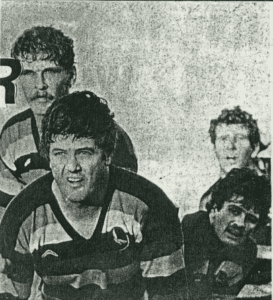
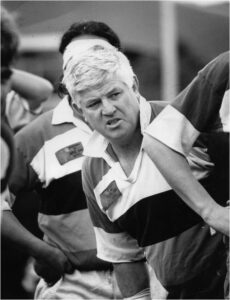
The Trench family is another one of the top 6 families ever to have been involved with the club as both players and administrators. Two generations have been involved and most probably a third will become involved in the Newcastle Griffins in the coming years.
Stuart: Started playing in the early 1970’s and continued with Stockton, Port Hunter, Tech Port, and Newcastle Griffins until the early 1990’s. A career of over 20 years. He was a no-nonsense, hard-as-teak front rower who never took a backward step.
-1974 – Newcastle Team
-1982 – 100 1st grade games and over 250 grade games for club.
-1985 – Life Member
-Treasurer – From 1971 to 1996 (25 years).
Linda: – (Stuart’s wife) was the second longest-serving woman on the committee after Merab Terry. Being the registrar and on the committee from the mid 1970’s to early 1990’s
Scott and Todd (Stuart’s sons): Both Played grade with Port Hunter, and Tech Port, and Todd was involved with the Newcastle Griffins as an administrator.
The Terry Family

The Terry family connection to our club is one of the best, if not the best in our history. Probably the only families to come close are the Jackson, Stokes, Trench, Robson and McNamara families. All these families were heavily involved in the administration as well as the players involved over two or three generations.
The four generations of Terry’s – George (Early 1930’s, his sons Reg and Don in the 1959 to mid 1960’s and Doug (Reg’s son) from 1977 to 1999 played for the club. (And Doug’s son, Garth 2014 to 2022). Both Don and Reg played in several Newcastle (Grade) representative sides. Doug played for u/18’s NSW country and U/18’s NSW (CHS) sides in 1976. Everyone who watched the Newcastle – v – Fiji games in 1961 will never forget little Reg tackling every Fijian who went near him, especially his opposing centre, who was almost twice as big and probably 10 stone heavier. Reg only came up to his chest. He never missed a tackle.
Both Reg & Don were centres and Reg also played fullback.
All three Terrys were selected in our Team of The Century, Reg as centre, Don & Doug as reserves.
That’s correct 3 from one family in the team.
Merab Terry – (Married to Reg and Mother of Doug)
Merab was our longest serving Secretary from 1974 to 1996. She also held the position of Registrar for several years.
Merab will always be remembered as one of the best, if not our best administrator.
Merab, Reg, and Doug are Life members
Garth has played for the Griffins.
Doug played over 200 1st grade games for Port Hunter in NRU 1st Division and over 100 1st-grade games for Newcastle Griffins in NRU 2nd Division and probably 350-400 games in total.
They are the only family to have:
* Four generations play
* Three generations made Life members
*Three players selected in the Team of The Century
What a history for one family.
The Davies family
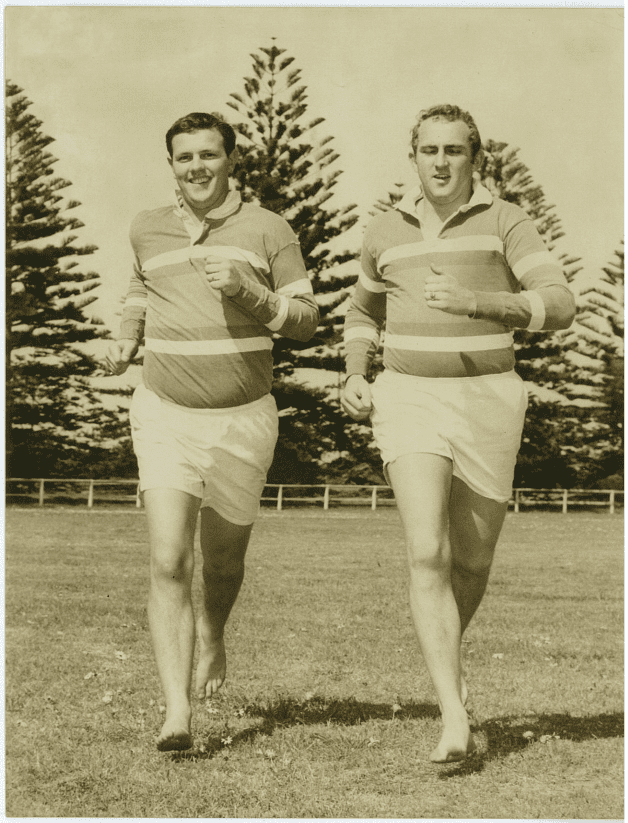
Since the reformation in 1959, the Davies family was one of the most influential families until the mid-1970s. Two generations have played for the club.
Bill Davies: Bill was the inaugural president of the reformed Stockton Rugby Club from 1959 to 1962. With Deputy President Bill Jackson they gave years of dedicated service that played the fledgling club on the way to success that culminated in the 1st grade team playing in two successive grand finals in 1968 and 1969. A great achievement in only a decade. His son Terry was the captain of both teams. Two of his sons, Terry and Tony, played for the club in the 1960’s and 1970’s.
Terry Davies (Bill’s Oldest Son): Terry was the second generation of the Davies family to play for our club. He was a second rower and one of the best captains. This family produced the first-grade captain from 1968 to mid-1970s and he was also selected as captain for many Newcastle junior sides, under 16s and under 18s. That’s correct, he was captain of the Australian under 18s who played the rest after the 1964 Australian Championship Carnival.
1962 – Newcastle U/16’s – captain
1963 – Newcastle U/16’s – captain
1963 – NSW Country U/16’s – captain
1964 – Newcastle U/18’s – captain
1964 – NSW Country U/18’s – captain
1964 – NSW U/18’s – captain
1964 – Australia U/18’s – captain
1966 – Newcastle U/23’s
In the mid-1970s, Terry Davies left Newcastle to run a motel with his family. He played over 100 junior and grade games for the club many of them in first grade. What a player and captain, he was selected as one of the best captains the club has had since 1959
Terry Davies’s younger brother Tony also played for the club and played for Newcastle under 14s and under 16 teams what a family involvement in the early years
The Jackson Family
The Jackson family is one of the top 6 families the club has ever had over the years.
In 1959 Stockton Rugby League Club disbanded, Bill and his friends recognised the need to provide a winter sport for the young men of Stockton. They banded together to then inaugurate Stockton Rugby Union Club, the forerunner for Port Hunter Rugby Union.
At the initial meeting in 1959 Bill Jackson was installed as deputy president, an election that signaled years of dedicated service and fostering, promoting, and looking to the welfare of Stockton rugby players in nurturing the success of this sibling organization. Bill was president from 1963 to 1970.
One of his outstanding achievements related to the formation of the Stockton Junior Rugby Club in 1960 and his effort was rewarded in 1963 when Stockton won the junior club championship. That was the first trophy won by Stockton.
Bill’s forthright approach and alliance with the late Dr John Bromley, who played for the club in the early years from 1959, resulted in the creation of harmony within the club which has endured over the years.
Heeding the immense enthusiasm of husband and father, Bill’s wife Moira and sons Kevin, Doug, and Greg became stalwarts of his beloved club.
Moira.
Together with the wives and girlfriends of members, Moira headed a hard-working ladies’ auxiliary who made their presence felt in strenuously pursuing fundraising activities.
Kevin.
Kevin started playing in 1963 u/14’s, under 16’s (1961, 1962), under 18’s (1963, 1964) and 1st grade from 1965.
After giving up playing, Kevin became a very successful referee. Officiating in many first grade matches. Kevin’s representative honours were Newcastle under 14, (1960), under 18s (1963 and 1964), New South Wales country (1964), New South Wales (1964), and Australia (1964).
Kevin was made of life member in 1980. He also played well over 100 junior and senior grade games for the club. He was also selected as a reserve in the team of the century
Doug and Greg.
Both started playing in 1960 in the under-14 side, with Kevin. They both played over 100 junior/ senior grade games for the club over their career until the mid 1970s.
Both represented Newcastle U/14’s, with Kevin in 1960.
That’s correct the three brothers were in the U/14 Newcastle representative side. A great achievement.
Margaret (Married to Kevin) Women’s Auxiliary 1966-1976
Comment – as said previously, I believe that the Jackson family is in the top 6 families to be involved in the Stockton/Port Hunter Rugby Club. – John Bevan.
Completed by – John Bevan, Reg Stokes, Neville Stirratt, and Roy Gorst.
Dr John Blomley (Jack Blomley)
Played for Stockton Rugby Club when it was reformed in 1959 and again in 1960. However, due to his commitments as a doctor to the Stockton community, he decided not to coach or play any away games.
Position Inside Centre
Date Of Birth 7 March 1927
Place Of Birth Tumbarumba, NSW
School St. Joseph’s College, Hunters Hill
Debut Club University (Sydney)
Province NSW
Date Of Death 15/2/1973
Service Number 2146748
Debut Test Match 1949 Wallabies v New Zealand Maori, 1st Test Sydney
Final Test Match 1950 Wallabies v British Isles, 2nd Test Sydney
Biography
Jack Blomley was a highly gifted inside centre, polished by his time under the tutelage of Brother Henry at St Joseph’s College, Hunters Hill who perhaps failed to reach his true potential due to the pressure of his medical studies. Nonetheless, he forged a dynamic partnership with the great Trevor Allan who later said,
“I loved to play next to Blomley. I considered him a magnificent centre. He made breaks galore and always gave me the ball at precisely the right moment for me to carry the move on.” From the 1st XV and Combined GPS teams of 1944. Blomley graduated from the University of Sydney where he studied Medicine.
He played his first representative rugby in 1947 for City and then the NSW 2nd XV before he won selection to debut for NSW against the touring All Blacks. Unfortunately, he injured a knee, was ruled out of the match and missed a golden opportunity to impress ahead of the third Wallabies tour. The following season Australia did not play a home test so Bromley was forced to wait until 1949 for a shot at national honours, which he duly won against the Māori in Sydney
He was then selected on the subsequent tour to New Zealand however it required a series of special representations made on his behalf to the University authorities for him to be granted the time away from his studies. Blomley won selection for both Tests against the British Lions in 1950 however his medical exams played havoc with his availability for the lead-up to the international in Brisbane.
Early the following year Blomley announced his retirement from rugby to concentrate on his medical degree, however, he did return to the game two years later and earned a spot on the tour to South Africa. Any hope he had of forcing his way into the Test side vanished in the uncapped match against Griqualand-West, one in which Blomley was honoured with the captaincy when he suffered a badly bruised ankle and was reduced to packing at number 8 in the second half scrums. He formally retired for good at the end of that tour and later, once qualified as a medical practitioner, set up a practice in Newcastle. In the mid-1960s Bromley joined the Citizen Military Forces and from April to December 1967 spent time on the ground in Vietnam where he earned the moniker – Jack the Quack from Nui Dat. Jack Blomley played seven Tests for Australia in a three-year international career.
Highlights
1949
Blomley won his first Test cap at inside centre alongside Trevor Allan in the 1st Test 3-12 loss to the Maori at the S.C.G. They were then paired for the final two Tests of the Maori series and each of the away internationals in New Zealand.
1950
With Allan ruled out due to a thigh injury Blomley earned his final caps in combination with Alan Walker in the 0-2 home series loss to the British Lions.
Robert(Bob) Cox
Bob played in the inaugural first grade game in 1959 after the club performed at Stockton Rugby Club. He played from 1959 to 1966 playing as a hard-working breakaway. He was the first player to play 100 first grade games for the club in 1965. He was also a representative player for:
1962 – Newcastle (Grade)
1963 – Newcastle (Grade)
1963 – NSW Country (1st player selected)
In 1966 he gave up playing rugby to concentrate on working at the State Dockyard Carrington where he was chief engineer and later general manager. However, Bob was still involved in rugby being a first-grade referee for several years until the mid 1970s. What a player and a person. The Cox family has had two generations play for the club.
By Jimmy Newton and John Bevan.
Jack Dennis.
Jack started playing rugby in 1946. In the late 1940s or early 1950s he joined the RAAF. He was always a front row who could kick goals and was very mobile. So during his long playing career, he scored many tries.
1951 to 1960 – Australian Services: – Playing against Fiji, All Blacks, Queensland and Sydney city. While in Malaysia he represented:
-
Northern Malaysia.
-
Malaysia – Touring Hong Kong.
1952 – Newcastle (Grade) From Tech College
1953 – Newcastle (Grade)
1954 – NSW Country (NZ Tour)
1960 – Newcastle (Grade) – From Stockton
1958 – Canberra (Grade) – Club not known.
Note: He played 98 1st grade games for tech college.
100 1st grade games for Stockton
92 first grade games for the RAAF
Estimated 15 1st grade games for Canberra
305 in total
Note: Jack’s son Peter also played for Stockton in the lower grades. Therefore they are a 2nd generation family who played for our club.
Many things will be said about Jack Dennis in the history of our club. All who played and knew him will agree that he was rugby through and through. Jack was my first grade coach in my playing career at Stockton. And he taught me so much in the short time I was there. As Brian Rudder said when he passed away “our great coach and player, Jack Dennis has passed away”. For the older members of our club, he was a rock that got us to so many semi-finals, finals, and grand finals in the 1960s, and in 1969 our first grade was undefeated minor premiers only to lose the grand final in final minutes 14-13 to Maitland.
Jack brought so many players from the RAAF to our club. He gave his all for us, and I personally can remember his chuckle so clearly as I type this.
authors comment – I totally agree with all the points in Brian’s obituary above. He will always be remembered as the greatest captain-coach the club has ever had. I played all my first grade career in Jack’s teams. (John Bevan)
Jack was also selected in/as:
Front row in our team of the century. Best coach/captain. Third best player to play for Stockton. What a player coach captain and general great bloke, a friend always remembered – completed by Peter McNamara and John Bevan.
Day family
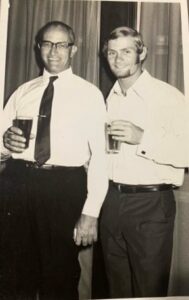
Jack (Honest Jack) – Jack was our club’s linesman from 1959 to the late 1970s. He was also a committee man of our club until he retired to Port Macquarie. He must have run up and down the sidelines for thousands and thousands of our games. Jack was made a life member in 1973 a well-deserved honour.
Jack and les played first grade therefore they are a second-generation family. All club members and players present at the game against Maitland in the early 1970s will never forget the day our winger scored the match winning try a minute from full-time, or we thought he had.
All looked at the halfway line where there stood honest Jack Day, our linesman with his flag in the air demanding “no try” when all players and supporters pleaded with him to change his mind. Even the Maitland players considered the try, but Jack couldn’t be swayed, even the referee tried to talk him out of the decision, so he had no choice than to order a line out. So, therefore, no try and no win. We missed out on the semi by one point coming fifth. That was our honest Jack. Jack was a hard worker for the community of Stockton and Port Macquarie, where he had retired.
President of Stockton and Port Macquarie Lions Clubs. Newcastle District Council of Lions.
Alderman of Newcastle city council (1977 – 1980).
“What a bloke”
By – Les Day and John Bevan
Wilson family
Ross (Roscoe) Wilson – was a hard no nonsense front row who played for the club from 1959 to early 1970s. He played over 100 first grade games, was first grade coach in 1966 and under 18s coach in 1964.
As under 18’s coach he was also coach of the Newcastle representative side as well as coach/manager of the New South Wales Country/New South Wales 2nd side – because of the strength of New South Wales under 18 rugby, two sides were selected – New South Wales country, and New South Wales city.
Note: New South Wales country won the Australia championship carnival beating New South Wales city.
He was also a committee member for years.
Sandra Wilson – Rosco’s wife – was on the committee for years ending 1964, and was the assistant manager of the under-18 New South Wales country team with Ross. A great family connection.
By John Bevan.
Stokes Brothers.
When the club formed as Stockton Rugby Union in 1959, three brothers, Bruce, Russell, and Reg Stokes were some of the first players to sign up. They were also members of the committee. Bruce was treasurer, Russell was secretary and Reg was a member of the committee. Positions they held for several years.
Over the early years, they all played first grade and coached first grade and reserve grade with Reg coaching under 14 and under 16 teams also.
All three brothers played well over 100 grade games, many of them in first grade. Below is a listed summary of their involvement with the club.
Bruce (oldest brother) Treasurer, Committee, 1st, 2nd and 3rd grade player; 1st, 2nd and 3rd grade coach.
Russell (Sniffy) – Secretary, Committee, 1st, 2nd and 3rd grade player. Captain/coach Reserve grade team, Won major premiership 1964, coached Reserve grade for 6 years.
Reg (Snags) (youngest brother)- Committee member for 20 years. Secretary, Coached 1st grade, U/14’s, U/16’s; 1st, 2nd and 3rd grade.
In 1969 was made the club’s 1st Life Member.
Snags played front row “through and through” however he wanted to be a half back. He never got tired of telling anyone who would listen to him that he was overlooked for the halfback spot. He always said his “dive passes” were better than anyone’s.
One thing that will always be remembered by all who were playing and watching a first grade game at Lynn Oval in the early 60s. There was a fight after a scrum broke out between three players. However it wasn’t between Stockton and the opposition. It was between the three Stokes Brothers. Unbelievable. Could only happen at Stockton. Brotherly love? Reg was also involved with the formation of the Stockton (Schooners) 2nd Div club in 1997. He was Secretary from 1997 to 2000, when it folded after winning the Minor & Major premiership, undefeated.
What a legacy all the Stokes Brothers left our club.
completed by Peter McNamara and John Bevan.
Comment – Reg would be in my top three club person and Russ and Bruce in the top 20 – John Bevan.
The Robson and McNamara family.
Bill (Harry Bowtie) Robson
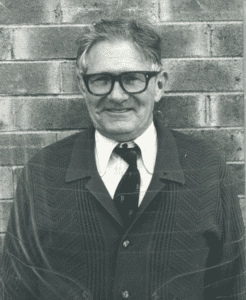
Bill became my (Peter McNamara) father-in-law in 1967 and was involved in the club and NRU Juniors from the time I met him. I always remember him taking several teams to their games in the back of his old grey Toyota truck that he drove for VG Hodges store in Newcastle West.
He always had a rolled cigarette hanging out of the side of his mouth, and naturally always wore a bowtie to work. Hence the nickname of Harry Bowtie. He was a stalwart of our rugby club and Newcastle Junior Rugby Union being a member of both, as mentioned above most juniors who played for Stockton under 14s under 16 under 18s went to games in the back of the Hodges truck. What an experience they will always remember a dozen or so players bouncing around in the back of the truck as it sped along the highway. What fond memories. We probably all heard him saying more than once he “couldn’t give a damn” to anyone who mentioned that it may be unsafe or illegal. A legacy of his war service.
Harry was one of our greatest clubmen and characters who used to say he was “a man who couldn’t be embarrassed”.
When we made the Grand Finals in 1968 and 1969 he along with Jack Day came up with the two great sayings – that I will always remember to epitomize the man – as a true supporter and gentleman.
” Stockton mate in 1968”
”Be a man…. Play Rugby with Stockton”
They threw the mold away after Bill Robson was born.
Completed by Peter McNamara, Larry Maher, and John Bevan.
Peter and Sandra McNamara
Peter first became associated with Stockton rugby when he was posted to RAAF Williamtown as a radio mechanic in 1961. He recalled playing with the Stokes brothers, the Fields, John “killer” Kearns, Bobby Cox, Ken “Wakka” Knight, and Reg Terry in first grade as an 11 stone 19-year-old.
He played first grade from 1961 to the mid 1970s with Stockton unless he was transferred away from Williamtown base by the RAAF.
Peter was one of our greatest players ever he:
-Played over 100 first grade games
-Played for Newcastle rugby (1966,67,68,69).
-Represented NSW Country (1967,68,69)
-1969 played in a match to select the Wallabies team to tour South Africa – (Unfortunately, he was unsuccessful).
-Coached 1st grade 1989 to 1991
-Selected as lock #8 in team of the century
-Was selected as one of best players to ever play for Stockton.
*See previous pages for a full list of his representative achievements.
-Was a committee member for several years.
-Played in the 1968 and 1969 1st grade grand finals (Sadly both lost)
-1971 – Won Anderson medal as the NRU Best and fairest player.
With his loving wife Sandra Robson, Bill’s daughter, he set up a house in in Stockton in 1967 and raised a family.
Peter became a true Stocktonian and was involved in many community activities and coached teams in various sports, especially basketball. Below is a statement by David Hayman, that I believe epitomizes Peter Mac exactly.
“Peter Mac, God rest his soul, a great bloke, footballer, and a good mate, and it all comes from playing rugby with Stockton. I will always appreciate the great mates from all I have made as part of our magnificent club”
Again, as I said about Bill Robson, they broke the mold when Peter was born.
Completed by David Hayman and John Bevan.
Sandra McNamara- (Bill’s daughter) Sandra had to be a great supporter of Stockton rugby club. She was born to it. Sandra was on the committee for many years and was president of the women’s support club for nearly 20 years. Naturally a great supporter of husband, Peter.
what a family
Roy (Pommy) Gorst
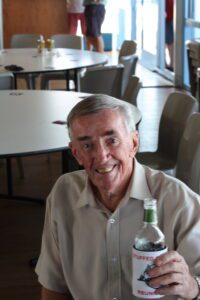
Roy was our original Pommy, joined and played for the club from its inaugural season when we were reformed in 1959, and up until his death in late November 2022 was still our best supporter. He went to every game the Griffins played at Lynn Oval, in memory of Stuart Trench.
He was little in stature but was all hot on and off the field. He played half-back and was a regular first grade player in 1959 and the early 1960s. He played over 100 grade games for his beloved club and was our super supporter and mentor to the young players, especially to the Nelson Bay boys.
“Reg (Snags) Stokes and Roy were like inseparable Siamese Twins until Snags passed away. They were best mates for over 50 years.
1959/1960’s – 100 games (grade) for the club.
1959 – 1980’s – Committee (various positions)
1959 – 2022 – Super supporter and member
1997 – 2000 – helped to formalize Stockton Schooners (2nd div) club.
Even though Pommy was a very quiet achiever he had friends in high places. In the 1970s and 1980s, he arranged for two of the best English rugby league players Vince Karalius and John Gray to visit Stockton and talk to motivate players from our club.
Vince also coached the English rugby league test side and John is widely regarded as the best all round sportsman to play for England.
He represented in league, union, and cricket tests.
Comment – Pommy was a unique and thoughtful person and a wonderful friend. – John Bevan.
Completed by – John Bevan, Doug Terry, and David Haddock.
Ernie Worrell
Ernie was a tall tough as teak second row who played mostly first grade from 1961 to 1970. He was a player who you wanted behind you in a fight on and off the field.
He represented the following:
1963 and 1965: Newcastle
1964 NSW Country – (2nd player to represent.) Also in 1964 coming back from injury.
He won a reserve grade grand final for our club. He then went to Mount Isa in outback Queensland for work. While he was there Mount Isa rugby started up and naturally Ernie played. He was also a player/coach of selected teams and a representative coach for several years. He played his last game at 42 years old. “Stupid ##” “Was breaking too many bones” that was our Ernie.
Ernie was selected as a second row in our team of the century. He played over 100 grade games many of them first grade. By – John Bevan.
John (Bevo) Bevan and extended Bevan Family
John is part of three generations of the extended Bevan family, who have played for Stockton/Port Hunter, and a third-generation Stocktonian. He was born and bred in Stockton. Bevo started playing in 1960 in U/ 14’s (1961/62), U/16’s (1963/64), U/18’s and first grade (1965,66,67). He was suspended for nine weeks (until 9th May 1968) only two weeks after returning from a 6 1/2 week tour of NZ with the 1967 New South Wales Country Rugby team. He represented every year he played from 1960 to 1967 (see full list in previous pages):
1960 – Newcastle U/14’s
1961 – Newcastle U/16’s
1962 – Newcastle and NSW Country U/16’s
1963 – Newcastle and NSW Country U/18’s
1964 – Newcastle; NSW Country, NSW, Australia U/18’s
1964- For the U/18’s Australian championships carnival NSW selected two NSW teams (City and Country). Each played 3x Games plus the final – Country Won.
1965- Newcastle u/19’s (v South Otago N.Z)
Newcastle (v Auckland Grammar N.Z)
1966 – Newcastle
NSW Country (-v-City)(-v-QLD Country) – Selected (Couldn’t play due to injury)
1967 – Newcastle
NSW Country (-v-City)
NSW Country (2 Tour) (Played 12 of 13 games on tour – Best forward on tour)
1967 – NSW (Selected but couldn’t play due to suspension) *Verbal confirmation only.
Total representative games played in selected:
Juniors- Newcastle (6 times), NSW Country (5 Times), NSW (4 times U/18’s), Australia (1 Time).
Seniors-Newcastle (5 times), NSW Country (15 times), Including 12/13 on NZ Tour.
*Owing to the above, I have no hesitation in selecting John Bevan as the best player to ever play for Stockton/Port Hunter Rugby Club, while playing with the club.
Naturally, he was selected in the team of the century as a breakaway. Bevo also coached Port Hunter first grade for three years from 1986 to 1988. During that time with coach Ken Grainger, Port Hunter won the 1988 NRU bicentennial seven aside carnival undefeated scoring 114 points to only 28 against in the four games played!
From 1997 to 2000 he was patron of the Stockton (Schooners) second division team that were the undefeated minor and major premiers in 2000. He played over 100 junior and 1st grade games. As you can see, John is a true Stocktonian, and Stockton Port Hunter grade through and through.
Extended Bevan family
Three generations of the extended Bevan family have played for our club.
Mel Bevan (John’s father)
John (1960’s)
Greg Corrigan, Mark Carpenter, and Dick Littlewood all in the 1980s. All played first grade at different times with both Greg and Mark (1986 and 1987) over 100 first grade games for Port hunter.
John was the best player to represent while playing with the club. I had the honour of playing with him at the club, Newcastle, and New South Wales Country team level. He was the best breakaway that I played with or against. I am also positive that Bevo would have played many games for New South Wales and Australia except for his nine weeks of suspension and defection to the league in 1967. This belief was also held by the following club, grades, and supporters – my father–in law Bill Robson, Jack Dennis, Bob Cox, Jimmy Newton, Reg Stokes, Roy Gorst, and many others.
John was also an all-around sportsman being selected in an Australian and New South Wales side for surf lifesaving, playing A-grade tennis and squash in the Newcastle district and Nelson Bay district competitions.
completed by Peter McNamara in June 2021.
Before the completion of this history, John tragically passed away in 2023, but his work lives on here forever. RIP Bevo – Brian Rudder
Brady family
The Brady family has had two generations play for the club. Brothers Vince, Tom, and Norm played in the 1930s and Jeff (Vince’s son) played in the 1960s and early 1970s. All played first and lower grades for many years. In 1932 Vince was one of eight Port Hunter players selected in the Newcastle Possibles vs Probables game to meet the All Blacks. Unfortunately, he was not selected.
Jeff (Tangles) Brady – played with Stockton from 1960 -(U/16’s, U/18’s, and grade) to the early 1970s.
He was a fast winger and played over 100 games (40 or so first grade) for the club. In 1982 he published the Port Hunter Rugby Club’s 50th anniversary history for the dinner held on Saturday, 20 March 1982 at Newcastle Town Hall. It was a great gathering of our history. The history is based on the contents of this document.
He played over 100 junior and grade games many of them first grade. This is not the only history of a club that Jeff has authored. In 1983 he completed the first of two histories of Stockton S.L.S.C. 1908 to 1983 (75 years) and in 2008, he published “Cardinal` Red and Royal Blue” (100 years history – of shipwrecks and Stockton SLSC 1800 to 2007.
What a family. Tangles RIP mate. John Bevan.
Hunt family
Two generations of the Hunt family played with our club. Arthur in the early 1930s and his sons John (oldest), Dave and Mick (youngest) in the 1960s. Arthur’s brother C.Hunt also played in the 1930s.
Mick was selected in the following representative teams –
1962-Newcastle U/16
1964-Newcastle U/18
1964- NSW Country U/18
1964- NSW U/18
Grade: -1969-Newcastle
He was also selected as a front row in our team of the century. He played over 100 junior and grade games many of them first grade. Also, his wife Carol was on the committee and women’s auxiliary for many years. His father-in-law Jack Bigmore was a great supporter and also played in several third and fourth grade teams when we were short of players, even though he was in his late 50s. He also played representative rugby in Wales in his playing days.
One of our great families. By– John Bevan.
Brian (Pommy) Griffiths
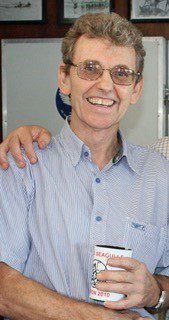
Brian started playing with Stockton rugby in 1966. He was one of Jack Dennis’s recruits from the RAAF. He played from 1966 to 1975 except for several stints transferred away from Williamtown base. Before coming to Australia, he played junior and senior grade rugby in Wales, where he played representative matches for Welsh junior teams and for (CWAVON) in the Welsh cup competition. Brian was approximately 70 kg when he started playing at Stockton. He proved to be an instant success at 5/8 due to his speed, technical skills, and general rugby ability. He was noted as one of the fastest backs in the NRU competition.
Jack Dennis, as first-grade coach, rated him as the best 5/8 and one of the most talented players ever to play for Stockton. Peter McNamara had similar thoughts.
In 1968 his combination with his great mate and fellow RAAF recruit John Bowie at inside centre was one of the factors that got the first grade side into its 1st grade Grand Final since 1932.
Unfortunately, we lost 9-3 to the Waratahs. Only for the fact that Phil Hawthorne (the incumbent wallabies 5/8) played for the Wanderers and after him, Peter Miller from Merewether Carlton (the New South Wales 5/8} were playing at the same time as Brian, I have no doubt he would have played many more games for Newcastle and achieved higher representative honours. He played two games for Newcastle teams.
1966- Newcastle U/23’s
1974- Newcastle (country week)
He was selected at 5/8 in the team of the century. Played over 100 grade games for the club. Only the fact that he was transferred away from the RAAF Williamstown base for several long periods stopped him from achieving 100 first-grade games. In 1975 Brian moved to Mount Isa to work in the mines after leaving the RAAF.
By Peter McNamara and John Bevan.
Alan (Supercoach) Barker
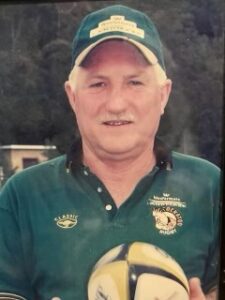
Alan was brought to the club in 1965 when he was 18 years old by John Bevan, who worked with him at Stockton hospital. Alan was a tough, no-nonsense hooker who played most of his games in 1st grade. No one would have thought he would turn into a “Supercoach”.
Playing career:
1965-1966- Stockton – After an injury to John (Killer) Kearns, Alan made his 1st-grade debut in 1965 and played in most games there until he was transferred to Sydney for work in early 1967.
1967 – Canterbury in Sydney 2nd Division.
1968 to 1970 – Played in England (rugby union)
1972- Played league for Waratah-Mayfield.
1973-1976 – Stockton/Port Hunter – Retired at season end 1976.
Played over 100 grade games, mostly in 1st grade over two stints.
Coaching Career:
His coaching career started at Maitland when he coached his son’s junior side.
1987 – Maitland U/15’s
Maitland U/17’s – Major Premiers
1989 – 1991 – Maitland 2nd Div – Major Premiers 1991
1992 – 1994 – Maitland 1st Div – Major Premiers 1994
1995 – 1996 – Mayfield East 1st Grade – Finalists 1995
1997 – 2006 – Wanderers 1st grade – Major Premiers 2001 and 2005
2002 – 2003 – Maitland 2nd Div – NSW Country Cockatoos in the Australian Rugby Shield ARS Champions in 2002. In 2002 defeated CANADA (ranked 10th in the world) 24-6 in a full international game at Bathurst. Country was the only team the Canadians did not score a try against on their Australian tour.
2006 – 2008 – Newcastle and Hunter Wildfires seniors’ representatives’ team won the Country Championship 2008.
2008 – Singleton 1st grade
2014-2018 – Newcastle and Hunter Junior Wildfires representatives’ teams – won country championships 2015, 2016, 2017, and 2018.
Retired at the end of 2018.
What a coaching career! Alan would be the best coach to have not coached Stockton/Port Hunter.
For sure, Supercoach! – John (Bevo) Bevan.
Brian (Mr Rugby) Rudder – OAM
Brian is rugby through and through. In January 2022 he was awarded the Order of Australia in the general division, a well-deserved honour for all the dedication and years he has given to rugby in Stockton/ Port Hunter and Newcastle Rugby Union. Several nicknames, Mr. Rugby, Mr Organizer, and one or two that can’t be written here (not really). When you read through the list below, you will know why he was awarded the OAM for “Services to Rugby Union”. He came to the club as an under-18 in 1960 after playing his younger years for the Stockton hockey club. After his first game, he knew he had found his true love, rugby. And never looked back.
Stockton/Port Hunter/Griffins
1966 – 1978- U/18’s, 1st grade, and other grades (see comment).
1971 – 1974 – Secretary
1982 – 1st grade coach
1977 – 1982 – President
1984 – Life member (Port Hunter)
2000’s – Life member (Griffins)
1970’s – 1986 – Team manager of numerous (1st grade and other touring sides)
1987 – Team manager/organiser of Stockton “stuffed seagulls” golden oldies tour to Auckland NZ. 1971 – 1986 – club delegate.
1981 – 1986 – Representative team selector
1981 – 1991 – Delegate to NSW Country Rugby Union
1986 – 1990 – Team Manager Newcastle Rugby Union
1987 – 1989 – Team Manager Country U/21.
1988- Team Manager – South East Asia Tour
1987 – 1989- Executive officer
1990 – 1992- President
1995 – 2013- Chairman-Judiciary appeals committee
2012 – 2014- Panel member – Appeals Tribunal
2013 – NRU Life Member
2015 – 2016- Board Member
2019- Chairman Awards Committee
Comment- I would’ve thought Brian had played over 100 first grade games. If he hasn’t it must have been close. However, he did play well over 100 junior and grade games
When asked, he said “clearly when I was playing we had several very good hookers” – Phillip (Jekyll) Hyde, Jessy Rolston, Brian Leary, and Alan Barker who shared the hooker role. However, I reckon I would have played a total of over 300 grade games overall. Due to this fact, I and many other players doubled up in the lower grades because a lot of Stockton players are not good travelers.
How true. I agree with Brian’s estimate of the total games played.
– John (Bevo) Bevan.
Ken Grainger

Ken played with the club from the late 1960s to 1981 mainly in first grade. He was a tough hard and skilful back who played mainly inside centre. Before playing rugby, he played junior and senior first grade rugby league for Central Newcastle.
Late 1960’s – 1981- 1st grade
1977 – 1978 – first grade coach
1981 – 100 first grade games
1988 – Coach with John Bevan winning the bicentennial seven-a-side championship.
1987 – 2000- President – Stockton (Schooners) club, who won the major and minor premierships (undefeated) 2000
Mid 1980’s – Newcastle representative selection.
Mid 1980’s – Referee for NRU.
John Bevan.
Peter (Bigtoe) Bland

Is the third generation of players to play for Stockton – Port Hunter. Peter was a giant of a man “on & off” the rugby field. He was a fierce and no-compromise player who anyone would like to have as a backup in a “blue”.
He played and excelled in many sports playing first grade in representative teams in the following sports mostly in Stockton teams.
Rugby Union to New South Wales Country level.Cricket to Newcastle level.
Basketball to NSW and NSW Country (Juniors) and Newcastle level in Grade.
Stockton Bowling Club to Pennant level.
See his full list of rugby representative selections on previous pages. He was also number four on the list of the six greatest players to play for our club. He played 100 1st grade games.
Peter was a Stocktonian “through and through”. He lived all his life in Stockton and is missed by all who knew and played with him.
He worked all his working life at Stockton Hospital, 44 years. Coincidentally, Peter took over my position at Stockton Hospital when I transferred to another hospital in Newcastle as supply manager in 1972 after nine years. He worked for 35 years with James (Jimmy) Newton, his best mate who also worked at the hospital. That’s an 88-year connection to the hospital. All 3 of us played 1st Grade for the club.
John(Bevo) Bevan.
Reid Family

The Reid family of father Colin and their three sons, Douglas (oldest), Michael, and Steven (youngest) all played for Port Hunter and Tech Port from 1987 to 1991.
Col always wanted to play rugby with his boys and said he could take one more thing off his “bucket list”.
Note: He was well into his 40’s when he played. John Waldie, who was a captain in the NSW Fire Brigade also played at the same time as Col and he was over 40 when he first played for Port Hunter and Tech Port. Both were champions and should be congratulated on their achievement.
Col – played in lower grades from 1988 to 1990.
Mick
Played U/18’s (1986)
1st grade from 1987 to 1991.
See his representative achievements listed previously. He played over 100 Junior /Senior games. All grade games 1st grade.
Doug
Played 1st grade from 1988 to 1991.
In 1988 Doug was a member of the Bi-centennial 7 a side champions that won the championship. In 1989 he was selected to play in the Possibles versus Probables match to select the Newcastle Rep team but was unsuccessful.
Steven
Played lower grades in 1989 and 1990. Then played with Mayfield East to play with his mates.
What a record of achievement for one family – one of the best in our long history.
John (Bevo) Bevan.
26) Stories from the Front Row- “Believe it or Not”
Stockton/Port Hunter Rugby Club has had some great storytellers, especially after 10 schooners. Below are stories from some of the best we have ever heard. I am sure they will bring lots of memories and you will all have a few laughs.
Stories by Larry Maher
1. Jack (Mr Honest) Day- probably one of the most memorable characters…. I think it was Jack (or maybe “Harry Bowtie Robson”) who came up with the “Stockton Mate in 68” and “be a man play Rugby with Stockton“ slogans.
He was the most conscientious/strictest linesman in rugby history. One mentioned occasion, was when the first grade was playing at Lynn Oval vying for a spot in the semis, and someone punted high for a follow-through. The ball sailed to buggery and landed first inside the sideline about 10 yards from the try line. One of us grabbed it and dived over to score a try to put us in front with one minute left. The whole team went mad because we thought we had won the game. As we all calmed down someone screamed look! Jack Day was standing on the sideline at halfway staring straight ahead, erect with one arm by his side, and the other arm with the flag up. When challenged by the whole team he replied, “ I consider the ball went over the sideline whilst in the air, and even though it landed inside the field, it was technically out”. That was ever “honest” Jack.
Well, talk about being a true “clubman”. I recall Jack Day and Jack Bigmore playing fourth grade a few times when we were short of players. Both of them were in their mid-60s, I would think!
It was so funny watching Jack Day on the edge of the ruck, trying not to get too deep. Jack Bigmore was a bit more, shall we say, ferocious (nature of the beast). What clubmen and characters?
2. Great Night at Blue Peter Pub
One time in the early 1970s after a game against University we went out to the Blue Peter Pub in Hunter Street and challenged them to a few dozen “boat races”. I think Uni won the footy, but we won the boat races, even though we were more handicapped by slow-drinking Snags. We had Mick Hunt who could down a schooner in one gulp.
After all that we all staggered out into the street. Snags could barely stand up he was so intoxicated. Four of us piled into his little green VW, with him at the wheel. He’d left the lights on so naturally couldn’t start it. Bowtie, myself, and one other (can’t remember who that might have been, Jesse Ralston or Mick Davis) all got out and pushed the car down the street as best we could while Snags tried to start it up. Eventually, after a few hundred yards it chugged into action. The three of us watched it drive into the distance never to be seen again. We were standing there in the pouring rain in disbelief. I think we might have gone back into the pub.
The next morning at the Chicken Run at the RSL we cornered him, Snags had no recollection of the night at all. “Lucky and naughty snags – ha, ha.”
3. Things were a bit different in the 1960s and 1970s.
As can be seen in the above story, it was a common occurrence that most of the teams would meet down at the Washtub on Saturday mornings at opening time for a few beers and camaraderie, maybe only the conscientious first graders held off the beer. One of these mornings, with the pub packed to the rafters, Brian “Grub” Hore had dropped his guts with one of his better efforts. It cleared the entire bar. Clive Moon, the publican was not impressed. He barred Grub for a week. Grub couldn’t believe it and was in tears. It probably rates as the only time in Stockton history that someone has been barred for “farting”.
Believe it or not.
4. 1968 and 1969 Grand Final defeats
The horror of our losing two consecutive grand finals is still unbelievable.
In 1968 it was probably more acceptable. We were mid-table until a run of consecutive wins put us into the grand final against the Waratahs. It was a close result (9-3) and the difference in the end was a bloke called John Hipwell, the Wallabies halfback.
1969 was a different ball game. We had a far superior side. We were undefeated minor premiers and went into the game favourite to beat Maitland. I’ll never forget Roger Stretton’s final-minute penalty or conversion from the sideline, drifting off at the last second and grazing the outside of the post, result Maitland 14 and Stockton 13.
I don’t think the club has ever gotten over that (not in my time/memory anyway). The look on Snag’s face as he walked to the dressing room. He knew that that was our one chance of glory. Also, I’ll never forget the look on the faces of all the players when we got back to the Washtub. Mick Hunt, Spider Haynes, Peter Mac, Brian Leary & all the others, but especially coach Jack Dennis. All putting on a brave face, but devastated.
I think a year or two later we finally snapped out of it. After going 14 games without a win we beat Tech College at Lynn Oval. You’d have thought we won the grand final. The entire club and suburb were carried out of the pub “pissed to the eyeballs” several hours later.
5. U/16’s Tocal Trip
I remember playing U/16’s when Snags Stokes took over as coach. On our first away game at Tocal (Maitland), he made the bus driver pull over at the Lochinvar pub and made us all drink a schooner (or two) of “stout & champagne” for stamina. ” Naughty Snags.”
Tocal kicked off, and the ball went to Peter Redman at fullback, who was playing his first-ever game. He caught the ball, looked wide eyed at all the forwards charging at him, turned around, and sprinted back towards our try line (a bit like Forrest Gump in the movie). Someone suggested it might have been something to do with our visit to the Lochinvar Pub on the way up.
6. Preliminary Final Loss
My own worst experience was losing a preliminary final against the Waratahs when we were 10 to 1 ! Through the season University and Stockton had been head and shoulders above all the other teams.
In the major semis, University beat us by a point (6-5).
In the final, we played very complacently and were beaten 6 -3 by the Waratahs. I am sure we were thinking about the grand final against University the following weekend. We were all in shock after the defeat. And what a team we had Gary Balcombe, Alan Sutton, Mick Davis, Roscoe Boyd, Clive Horan, John Hor, and all the others. We all believed we’d get our revenge on University a week later. Incidentally, University thrashed The Waratahs 27-0 in the Grnd Final.
Comment – don’t count your chickens before they hatch. John (Bevo) Bevan.
7. Punch Ups with Boolaroo
No player from either side will ever forget the games we played against Boolaroo. Another memorable game was a hot-tempered game against our favourite enemy Boolaroo. I think it was in 1971 when punches were being thrown all day on the field by both sides. When the game was over, the usual guard of honour was formed by Stockton. As Boolaroo was walking through, one of our staunchest supporters, Mick Hunt’s father-in-law Jack Bigmore reached through and decked the Boolaroo prop John Nicholson, who he blamed for starting several “all in brawls” on the field. Jack had played for Wales when he was younger, and the all-in brawl was on again. Great memories from a club full of characters.
Bevo’s comment – yes Larry I remember the game and brawls well. After one of the brawls was over when I got hit from behind and received my second fractured cheek. Thanks for remembering me again. I had come back to the union after three years with Lakes and was suspended for 10 weeks before I could play again. This game was only my first game back from the suspension. So next year I went back to league and played another six years with Lakes, Souths, and Waratah – Mayfield teams.
Larry’s reply – Mate, you’ve brought up a touchy subject. I remember getting clobbered and your fractured cheek because it was me and you that came into avenge. One of the Boolaroo players decked me and I was on my back looking up. You came from nowhere and hit whoever hit me, then you got whacked from behind. I felt guilty and never thanked you. Win some – lose some.
8. 1st win for 14 games and great haircuts.
In the early 1970s, we beat Technical College after four straight losses in first grade. The entire club got pissed at the washtub. Many of us decided to kick on at the RSL when the pub closed, as you did. Bit of a dilemma in those days because you couldn’t get into the “Rissole” if your hair was over your collar. So Allan Sutton came up with the answer. He took five or six blokes to his place, put a saucepan over their heads, and trimmed down the bottom edge, ugliest haircuts of all time, but we were all allowed into the club. I think Vince Casey’s hair was the longest at the time. He had a few regrets the next morning.
” As I said, only a few personal memories. Larry Maher”
Harry the hero?
There is a story going around that during World War II Bill was a fighter pilot for the RAF. He also served with distinction in the Pacific.
Comment – Go Harry, you were a hero and a champion in real life. – John Bevan.
“Try time “ reminiscence for Jack Dennis.
They packed down, Snags was hooking, Mick Hunt and John Boyd wrapped around him. Stuart Trench and Roscoe Boyd tightly knit in the second row – held tight on both sides by Peter Mac Gary Balcombe and Mick Davis as breakaways. The ball comes out. Half back Clive Horan flicks the ball to Jim Bowie who turns it inside to a rampaging Roger Stretton, who had chimed in from fullback, he kicks head where a flying Johnny Hor picks it up and tosses a long overhead past to his younger sibling Col. “Try Time“
All look up to the coach’s box where Jack Dennis is clapping his hands and laughing.
And they’re just the ones I played with! (and can remember).
Story by Les Day – to enforce the previous story on Jack (Honest) Day
Les remembers the day he was playing first grade on the wing against Brisbane Waters in the early 1970s. Jack was our linesman. His opposing winger, who was a Newcastle rep, punched and dropped Les. When he looked up, Jack was looking down at him with his flag in the air from a penalty. Les said “why didn’t you hit him with your flag.” Jack replied “You’re big enough to hit him yourself”
Stories by Brian Rudder (Mr Rugby/Organiser).
“Lower-grade players are not good travelers”.
It is a known fact that players from our lower grades are not good travelers outside of Stockton.
Brian reckons that he and a lot of other players had to play numerous games on the same day due to a lot of our lower-grade players not being good travelers, and therefore not turning up for games outside of Stockton. Meaning that these players who did travel had to play sometimes three or four games so that all our teams could play. He reckons that some players including himself would’ve played 300 to 400 grade games over their careers.
He remembers a game, last one of the competition rounds, versus Maitland at Maitland. He went up to cheer on fourth grade and ended up running on as a hooker for Fourth, Thirds, Seconds and First Grade….lasted about twenty minutes in First grade before calling it quits. “Four games of bloody Maitland Forwards rucking over you, I was looking like I was whipped”. Thanks, Boys you really did not like to leave the Peninsula.
That many Brian – Ah well maybe ?
The” send-off “ during one of these games – This is definitely one of those “Believe It or Not Stories.”
At a game against Brisbane Waters in Gosford. First-grade players Brian Rudder (hooker) and Mick Davis (5/8) were playing for the fourth grade as half and 5/8 respectively. As we all know Brian‘s passes were not the best part of his game and after about 20 minutes Mick told Brian during a stoppage in play to “leave the field” “ Your Off” he told him. In other words, he sent him off. When the referee asked what was happening, Mick told him that he had sent Brian off because his passes were too bad. The referee shrugged his shoulders and Brian walked off the field muttering some very strong words. They laughed about it afterward. Brian did say his passes were terrible.
This has to be the only time that a player has been “sent off” by another player on his own team –
“ unbelievable “
Stories by David (Stumpee) Hayman.
Gold Coast nightclub goes mad.
On one of our many and memorable trips to the Gold Coast. All the boys were in a nightclub in Coolangatta when the infamous rendition of the “Blues Brothers” song was sung on stage by Roscoe and John Boyd, Stockton’s Blues Brothers. After the song was over, the whole nightclub crowd went mad and gave them a standing ovation as the bouncers were trying to drag them off the stage. Another memorable night in paradise that will never be forgotten or more likely remembered due to the amount of grog drunk.
Memorable Games
Game 1:
Coach Jack Dennis threw me in at the deep end when we played the Waratahs that included Wallaby half and hooker, John Hipwell and Peter Horton respectively, who were playing their first game after a tour to England. I didn’t know what to expect. At Thursday training night Jack had announced the team and Ron Hinchcliff and I had swapped positions, much to our surprise. Before the game Peter Mac was captain and he just put his hand on my shoulder and said “don’t miss the opportunity. Hipwell is just another half back. The best thing you can do is when he dive passes, just walk all over him”. So naturally, I did the Bigtoe on him and promptly got sent off, the game ended, and we all went to the pub and enjoyed some well-deserved refreshments.
In the first half, it was getting to Hippy. At half time he gave me a gentle warning, like a school teacher would, stop walking on him or you will suffer consequences, the referee is getting upset. Just after half time, I made a break and passed to the 5/8 Pommy and all I remember is getting up off the ground, holding my head, and seeing Alan Sutton throwing punches at Horton. That’s what it was like playing for Stockton – you always look after your mates and never take a backward step. We might have got beaten on the score board, but we loved playing for the red white and blue and it was always ”one in all in”.
Game 2-
It was written up in the Sunday paper after the game as the “Battle of Port Hunter”, Stockton v Maitland.
I think we got beaten by a couple of points. The illustrious “Gollan brothers” from Maitland loved to stick shit in whenever they could.
We had some great and hard forwards, Peter Mac, Al Sutton, Bigtoe Bland, Stuart Trench, etc who liked to mix it up also. Peter (big toe) Bland got taken out in a line out on the 22-yard line and didn’t like it so he had a go back only to be grabbed from behind by the redhead Rory and was copping a hiding from the other brother. I saw a redhead over Bigtoe’s shoulders and jumped up and landed a right hook square on Rory‘s nose and Bigtoe broke free, the rest is history. I have never seen a bloke head butt like “the toe” he didn’t miss any of them. The referee arrived, blew the whistle and the blue ended.
Footnote to game 2- a long time after the game, Peter Mac and I were working for Alan Bragg fireworks at the Newcastle show. We had set up the fireworks for the night and went to the pavilion for a couple of beers as you do. Who do you think we ran into, the “flying Gollan’s from Maitland Club” as they were called.
Peter Mac the smart arse said to Rory as he pointed to me, “He’s the one that flattened your nose at Stockton in the battle for Port Hunter”. We all laughed and had several beers together and reminisced other games. That’s what playing rugby is like – most of the time it stays on the field.
Peter Mac, God rest his soul. A Great footballer, family man, bloke, and good mate and it all comes down to playing rugby with Stockton.
I will always appreciate the great mateship of everyone I have known in this magnificent club. It has been my honour to be a part of the red, white and blue. – David (Stumpee) Hayman.
Totally reiterate Stumpee’s words in full – John (Bevo) Bevan.
Stories from John (Bevo) Bevan
Naughty “Pommy” Griffiths – suspension
One night after many schooners, Pommy told this story that most people wouldn’t know. Just before he immigrated to Australia, he was suspended from playing rugby in Wales “for life” by the Welsh Rugby Union for accepting money for playing. At that time rugby was an amateur sport. The practice, at the time, was a rival club would place an amount of money in your football boots while you were having a shower. Unlucky Pommy got caught.
Comment – four weeks was a long suspension – but life? – naughty Pommy. (John Bevan).
My 9-week suspension in 1967
I was only playing my second game back with Stockton after a 13-game tour of NZ with the New South Wales Country team in 1967. We were playing Maitland at Lynn Oval, Stockton.
Just after halftime, I was “stiff armed” by a Maitland forward. We got the penalty and I had just got to my feet when the same forward said “How did you like that Bevo?”. I said something back to him and threw the ball at him. That started another “all-in brawl”. When the brawl was over the referee, Brother Gordon (Catholic brother) blew the whistle and sent me off, “while doing and saying nothing to the Maitland player who “stiff-armed” me.
Naturally, I really cracked the shits and gave him a mouthful of choice adjectives, refusing to leave the field, saying “there’s no one on the field good enough to make me leave”. Holding the game up for 15 minutes.
Eventually, I finally left the field in a very bad mood – punched a hole in the change room, etc. At the NRU judiciary committee meeting, I was finally given nine weeks of suspension until 5th May 1968. I was charged with language, intimidation of the referee, and misconduct on the field of play. I appealed to the NRU and ARU but both appeals were rejected.
After thinking over my options for four months I finally decided that because I couldn’t play in Country Week in April 1968, my representative options in rugby union were over, so I decided to sign with Lakes United League Club for three years.
Wrong decision – this turned out to be the wrong decision, about a month after I signed for Lakes I was talking with Neil (Noodles) Adams at a Merewether Carlton game. Neil was a New South Wales country and New South Wales selector, and he told me that even though I couldn’t play in Country Week I was already “penciled into” the country 1st’s, New South Wales, and Australian sides in 1968.- Oh well unlucky.
To this day I still hate ref Brother Gordon.
Bevos’ training torture tracks
I was first-grade coach for Port Hunter for three years from 1986 to 1988. Everyone knew I was a fitness fanatic so over the three years I came up with some “torture tracks” in preseason training.
(1) Run over Stockton Bridge – the run over the bridge is probably just over 2 km. So in a session, we would run it three times, at least, depending on if I would catch anyone on a run. The rule was that I would give all runners – three minutes start, if I caught anyone all the runners had to complete the run again. Paul (rhino) Ryan, who was captain at the time and one of our best players on the field, was a lazy trainer.
On one of our training sessions I caught rhinos three times, so everyone had to run the bridge six times, not three times.
Lazy rhino, and very shitty and unhappy with other players.
(2) 100-foot drop – sandhills at Fern Bay.
Another great training session was the 100-foot drop sandhills at Fern Bay. All players had to run up and down these hundred-foot sandhills five or six times depending on their commitment to the session.
(3) Glenrock Lagoon run – Merewether.
The Glenrock Lagoon run was a 45-minute run over a 5 to 6K course from the track above the lagoon down to the beach and then back up a creek and back to the starting point. Another great run.
Rugby games between Navy ships and Port Hunter
When John Bevan coached Port Hunter between 1986 and 1988, Stuart Trench and he were members of the Newcastle Rotary Club. One of the other members was the customs Manager for Newcastle Port. Conversations between them led to Port Hunter would play a team from the Australian Navy ship that was due to visit the port and was looking for a game of Rugby. Over the three years, Port Hunter played five visiting naval ships from Australia, the UK, and the USA. They were the HMAS Hobart, HMAS Sydney, USS Ingersoll, Uss Eagle, and the Royal Yacht Brittanica.
All games were played at No 2 sports ground Newcastle and were great games played in the spirit of rugby.
Naturally, after every game players from both teams and supporters went back to Bevo’s Newcastle Hotel. Where many beers and a great time were had by all.
P.S.- Port Hunter won all the “boat races” except the one against the Britannia. (See separate story – it is a believe-it-or-not story.)
Crewman from Royal Yacht Britannia – “boat race”.
A petty officer from the crew of the Royal Yacht Britannia is the best “Beer Boat race” competitor I have ever seen. At the show after the rugby game, he beat six players from Port Hunter, drinking six beers while standing on his head, gripping the beers by his mouth while being moved along beers placed on the floor by another player – unbelievable.
“Snippets” from after-game party at Newcastle Hotel – following win NRU seven aside championship.
I said previously – Bevo’s Newcastle Hotel rocked into the early hours again, following the win in the NRU bicentennial seven aside championships on 22 May 1988.
-Senior Brodie shows he loves kickoffs.
-Ken Cooper made an ass of himself after they scored a try (Had to give a victory dance)
-Ken Cooper – gave a rendition of Co–coach Ken Grainger’s game plan and motivational speech –“ go for it” and had the pub in stitches. However, it worked. We won – scoring 114 points to 28 against.
Well done both Ken’s.
Countless “ boat races” were raced over the night, and naturally countless schooners were consumed.
A great night was had by all and the song “We are the champions” by Queen was sung numerous times.
By Bevo (John Bevan).
The Three Guinness Amigos
For almost 2 years from 1986, the Newcastle hotel that Lynn and I ran was the only pub in Newcastle that had Guinness Stout on tap.
The three Guinness amigos (John McInerney, Stuart Trench, and myself) used to meet up almost every Sunday afternoon and drink numerous pints of Guinness.
We drank at least an 18-gallon keg a month.
Great days – can’t remember all of them. (By – John Bevan).
“Golden rivet” in the engine room of Royal yacht Britannia.
It was the case in most Armed Forces around the world before the 2000s. A little “hazing” occurred to young recruits of the Royal Navy and Royal Marines when they joined the Royal Yacht. One was the ritual to send them looking for the golden rivet. Naturally, it was never found.
Eventually, the Queen heard a rumour of the gold rivet and wanted to see it. The crew hastily found a tin of gold paint and painted a rivet in the engine room gold – this was the birth of the “golden rivet”.
When Her Majesty was shown the golden rivet in the engine room, she was also presented with one painted gold as a gift. All good.
My wife, Lynn, and I were lucky enough to have been shown the “golden rivet” when we were invited aboard the Royal Yacht by the crew. Due to the fact, that most of the Royal Marines drank at our Newcastle Hotel, because we were the only pub at the time, to have Guinness Stout on tap.
By John Bevan
Stories from Ian (Hoss) Cartwright
Recollections of Brian Rudders end of season Coolangatta trip.
1. “BOYD BROTHERS” SING AT NIGHTCLUB.
Early 70’s I was playing U/19 league and having a few games of Rugby.
Brian Rudder had organised an end-of-season trip, someone pulled out and I ended up getting a start. All the usual suspects were involved, Rosco, Bruce Evans, Charlie Moffat, Ken Grainger, Dave Hayman, Steve Lindstrom (more on Lino later), and assorted others of varied notoriety.
Arriving at Williamtown to catch the Fokker it was true to say some had a few beers before departure.
We board the plane, 26 in our group and three nuns.
The hostess makes her flight announcements and advises only 27 beers were on board Brian, as he had arranged the trip, claimed the spare.
We arrived at Coolangatta and headed to Kirra Beach Hotel, our accommodation, and booked in. It was then time for a few cold ones. As the night wore on we found our way to a small nightclub one street back from the beach. A rumour got around the nightclub about a great singing group in attendance. A short while later one of the group has filled in the MC on the talents of this group of singers the MC takes the stage.
By this time the touring rugby group is starting to have a bit of a laugh as the MC rattles off his spiel about this wonderful group who have just performed before record sell-out crowds around Sydney and introduces the “Boyd Brother’s” of Ross (Roscoe) Boyd and Bruce (Ombo) Evans. To rapturous applause and laughter Rosco and Ombo mount the stage.
The pianist asks Ombo what key do they want?. Ombo’s response was “give us a couple”, which the pianist does. Ombo says yeah that one will do, and the band starts to play and they start to sing the most tone-deaf and out-of-tune rendition of “Apple Blossom Time” ever heard. The rugby boys are by this time rolling around laughing, the crowd is booing, and the MC is looking for somewhere to hide so he gave them a little leeway with a second song. The pair burst into a rather ribald rugby song and with that, we all got asked to leave. Must say the pair of them couldn’t carry a tune in a bucket, very funny.
2. Road Trip The Next Day.
Dave Hayman hired a Mini-Moke to get around and some of us jumped in with Dave to head to a nightclub further up the coast on Saturday night. Naturally, some alcohol had been consumed. We head off up the highway, Dave driving, and he starts putting two wheels up onto the nature strip driving through the small bushy shrubs. Over a couple of kilometers, we shredded some shrubs. All went well till Mother Nature hit back and Dave ran into a white pole hidden in a shrub. The little pipe bull bar on the Moke made a hell of a noise but no more driving through the shrubs. Took a bit of explaining the damage to the hire car company.
3. Steve Lindstrom.
Linno had only just gotten out of the hospital after losing the lower part of his leg due to a hunting accident.
He could perform and drink with the best of them so to see Lino standing on his head back against the wall with his good leg being held against the wall to keep him upright was a sight. He did this so as to be able to drink a schooner while on his head the locals loved it.
That was Linno’s entrée we decided to swim Kirra, and Linno left his artificial leg on the beach and was helped into the surf. After we all had some time in the water there was a great scream let out as Linno came hopping out of the surf with his amputated leg waving and singing “Shark, Shark, Shark”. Needless to say, it caused pandemonium with those in the water as they all rushed out to find Linno laughing his head off.
4. The return trip.
Arriving at the airport for an afternoon flight, all with a few on board, it was noted by airport staff that some members of the party had no footwear and were not allowed to board the plane without footwear.
Being the ever-thinking group, as Noel Burns wearing thongs got to the top of the steps, then quickly threw the thongs back over the fence for someone else to repeat the process, all in all, a very funny weekend
5. Some General Memories.
Playing Hamilton at Marist Park is always boggy and built on an old tip, but worse after rain. Packing a scrum down a rather large frog hops between the two front rows. But how good was it to come off Marist Park on a cold, wet, and windy day a have a great cold shower?
6. A couple of memorable on-field events both involving hookers.
Kerry Keating played a couple of years with the club and had an artificial lower leg this didn’t impede Kerry too much and he got around the ground very well.
Might have been Wanderers at Lynn Oval, there was a ruck that collapsed, and the ref has blown it up.
As bodies start to separate a scream goes up from one of the opposition players that he’s pulled someone’s leg off. He had a look of sheer terror until Kerry quietly hopped over refitted his leg and carried on with the game.
7. Dale Anderson.
Dale enjoyed a drink or three and after a particularly heavy night turned up to play at Lynn Oval.
After running around for a while and packing a few scrums Dale is starting to feel the effects of the night before. The ref calls another scrum, and we all get set, Dale has his arms over his props and as the two packs come together Dale projectile vomits over the opposition hooker. We came out on top in the scrums that day for some reason the opposition was reluctant to pack down after that.
8. Greg Corrigan and Dr Cartwright.
Corro had got himself split open in a big way on the cheek and head in a game at Lynn Oval. Hoss volunteered to take him to get sorted. Contacted Dr Mike Hamidi and said he’d meet us at the surgery. Mike assesses Corro and then says the obvious, “You need stitches “and says to Hoss you can come and watch. So, Mike spends a lot of time stitching Corro’s cheek then says to Hoss “How’s that look?” whose response is “a bit untidy, probably needs a few more” so Mike dutifully adds several more stitches.
Mike says to Corro your good to go. Hoss being the caring person he is suggests to Mike that Corro is still bleeding from the scalp, so Mike goes searching and puts about another 6/7 stitches in his scalp. Corro still appreciates the input of Hoss on that day ….NOT.
Stories from Geoff (Jessy) Rolston
1. How I started playing rugby and front row.
I started playing in 1964 in U/16’s. The junior teams were training at Lynn Oval. Snags asked if I wanted to have a go. He asked if I had played any rugby union, told him I’d played wing and fullback at school (rugby league). I was a little amazed when he put me in the front row – may have seen more potential for me there.
As you can imagine there was a lot of advice from Snags on what to do in the scrums. Also from his brother Russell (Sniffy) “you need to hit them before they hit you” – sound advice? With Snags, he just loved to advise on “how to grow up as a person”, especially their advice on the opposite gender. But just watching the games and grades and the front-row battles was my best education. Also had a lot of advice from Mick Hunt and Peter Frazer, our first-grade front rows, at the time. Watching the old oldheads Jack Dennis and Ross Wilson was great also. Very tough and knowledgeable guys.
The main thing I learned was not to back down. I remember a game against the Waratahs in U/18’s.
One of their front rowers was trying to be a tough guy. Gary Balcombe came up to me and said “Next time he gets the ball I’ll tackle him low, you come over the top and hit him around the head”. That made him quiet for a while. We had a forward pack that was fairly solid, especially in a blue. Everyone backed each other.
Great memories.
2. Is Rugby Non-Political – Non-Sectarian?
One of the funniest things I’ve ever seen on a rugby field was when we were playing Mayfield East U/16’s coached by a minister of religion. I was screaming at the referee about anything done by Stockton players. Dave Parker, one of our players was about to throw the ball into a lineout. However, he turned and threw the ball at the M.E coach. It was a great throw, spiraling end over end, hitting him in the face, he then hit the ground. We all laughed. I think Dave may have been sent off. It kept the whingeing coach quiet after that though.
3. Can you trust all you read in newspapers?

Hamilton Marist as they were known had an U/16’s and U/18’s carnival at Marist Park in 1965/1966.
Most of the Newcastle clubs attended, plus several Sydney clubs. Stockton U/18’s got through to the final and played Randwick who had won the Sydney competition. We defeated them 10/6.
Stuart Roach wrote in Newcastle Herald, the next day, that outsiders helped Stockton win.
We had Dave Fordham and Bruce Devir filling in for two of our injured players, not much about the fact that we won all our games easily before the final. Typical Stuart Roach didn’t think much of Stockton Rugby or a good enough reason to congratulate us.
4. My first two first grade games (as a junior)
Game 1 – was against Merewether Carlton. Jack Dennis asked me to play 1st grade (from U/18’s) as hooker because John Kearns the 1st grade hooker had to work.
Playing grade while playing juniors, you discover that you’re not as tough as you thought you were very fast. I played against Warren Chipchase and held my own, but I tired quickly and was worn out by the end of the game.
Game 2- was against Wanderers, where I found out again that I wasn’t as tough as I thought I was. I packed down against Ross “Mad Dog” Turnbull and several other hardheads, who were a bit smarter and tougher than me. But I enjoyed it (getting belted – NOT).
Lower-grade games (a bit slower).
Played low-grade with “Snags” and “Sniffy” Stokes and Roscoe and John Boyd plus various blokes from the RAAF and army base. Wasn’t too hard to keep up with them and our opponents. Used to have a great time with all of them, as you would all know. Lots of great characters who enjoyed a good time and a few beers (too many beers).
5. Card night at Gladstone Hotel
One night after training about 20 of us were having a few beers and some were playing cards at Johnny Alterators’ (reserve grade coach) in the Gladstone Hotel lounge area. We were all having a great time and I was just raising “the kitty “ when in walks the local police sergeant. He herded us all out of the door and said to John Alterator, the publican, “We’ll talk about this in the morning. We found out the next day that bloody Roscoe Wilson had seen him pull up, but he ducked out the door, and never told anyone the police were here!
Comment – you can’t trust a front rower – John Bevan.
6. Chinese dinner and thongs in – hand
As was said above – about not trusting a front rower. Peter Frazer was an expert in getting Chinese meals for free. By the old “thongs in hand” and out-the-door method! He would have sampled free meals from all the Chinese restaurants on Hunter Street.
Naughty Peter – he wasn’t slow at the door.
“Thanks Jessy”
Story by Brian (Boxhead ) Oshea. University Coach.
“Oh My God”
I remember a 3rd Grade match between the University and Port Hunter at Lynn Oval. John Dodwell a regular selection in the Newcastle Representative team had an afternoon wedding and so he played in thirds for Uni. He started nice and easy . During the first half he realised that Uni was getting belted about and so he went into a ruck and used his feet with enthusiasm, he was looking down when he saw a detached leg pass him and out the back of the ruck. Until he found out that it was an artificial leg he thought he had done a terrible injury to someone.
“Needless to say Kerry (Buster) Keating hopped over to his leg and nonchalantly reattached without a word being spoken. LOL. A classic moment.”
Stories by Terry (Blubber) Davies
“ Sniffy” Stokes, and the Carpet Snake.
After training in the mid 1960s about 10 of us were sitting around and talking. Suddenly Ross Wilson said, “oh shit I left my training bag in the shed.” “Sniffy” pipes up and says “ I’m going to get something out of the shed and I’ll get your bag for you,” Roscoe said great, and all was well.
After about five minutes we all hear a great yell and scream. Outcomes Sniffy, running as fast as his little legs could take him to his flat at the back of the beach kiosk, where he lived across the oval. We all look at Roscoe and say what’s wrong with him?
He tells us that he had placed a big carpet snake in his training bag. Knowing that “Sniffy” was terrified of snakes. Poor sniffy he almost had a heart attack and never forgave Roscoe, or the rest of us for laughing at him.
Snakes, alive! – Don’t trust your front-row partner.
Story By Stewart Hutch.
One Year and a Lifetime of Memories.
I only had one year (1983) at Port Hunter with Brian Rudder as coach, but I am fondly reminded daily of that year. I look in the mirror at my bent nose and remember David Chisolm screaming at me to stop the flanker from Newcastle NZ getting to him off the scrum at Stockton, so I did, but my nose copped the punishment from that gallant gesture.
Then I look at my right hand and see the knuckle of my small finger way out of place as a result of “Big Toe” having trouble with an opponent in the lineout taking him out in the air. Once again he suggested that he could do with a little help, so after hitting him as hard as I could in the side of the head, my knuckle has been a constant reminder ever since.
Story by Brian Griffiths.
Three Semi-Finals, two draws and one loss!
In 1965 Stockton and Merewether met in a semi-final in first grade, the game ended in a draw 13 All. The next week the two sides met again and remarkably it ended in another 11 all draw. The third week Stockton was without its halfback with a broken shoulder Lindsay Gailey (the best halfback in Newcastle at the time) and five-eighth Pommie Griffiths who had dislocated his shoulder in the last game of the season. Sadly they were beaten in that game and Merewether Carlton advanced to the Final. Newcastle Rugby Union had to change their rules after that to avoid this happening again, in the event of a draw the team with the most points at the end of the competition rounds advanced to the next round, as because of these two draws the rest of the teams were sitting around to play the final, etc.
Lighting
Few of our remaining members will remember that we primarily used to train under the glare of “Two World War 2 ” searchlights! That’s right they were our only lighting for the entire ground and they were positioned on the roof of the old grandstand at Lynn Oval. They used to move around a bit from the North Easter and Southerly winds that prevailed, so before training someone would be required to climb onto the roof and reposition them as directed from below. These searchlights also had seen better days and the luminance from them was not great so the First Grade got the privilege of training close to the grandstand side of the ground whilst the other grades trained on the other side, in an almost total dark state, I think this may have led to our lower grades struggling, who knows. Thou I do know that the semi-darkness certainly allowed a lot of not-too-keen trainers to slip off into the night. Especially as Jack Dennis always finished training sessions by ordering us to do “three laps around the oval”, I never understood why as maybe half of those left disappeared in the darkness.
“I doubt any other club trained under such circumstances. Brian Rudder”
In 1970 we had raised via donations and savings enough money to buy modern state-of-the-art lights for the ground. The only problem was that we did not have anywhere near the money to buy posts and have them erected. Fortunately, I was working for Shortland Electricity and I took the opportunity to explain our predicament to the Council Installation Crews, who would you believe delivered, and it was big time. The Shorltand Nesca crews arrived shortly after and directed by us erected four massive posts, installed the lights, and connected them up to a meter that certainly wasn’t in our name. Yep, that’s correct the club NEVER received a bill for the electricity from then on. I suspect Newcastle City Council unwittingly was our benefactor, and I suspect that this might be the case to this day.
“A case of being in the right spot at the right time” Brian Rudder
Alan Linstrom
“Legend”

No other words can be conveyed
27) End of Season Trips
Our club excelled in one area, and that was end-of-season trips. in the 60’s it was Ryleston, in the 70’s anywhere that we hadn’t been before as our adventures often precluded a return visit. Most times the bookings were made under the name of Port Hunter Badminton Club, otherwise we doubt whether the booking would be accepted. There were some exceptional ones to the Gold Coast and to Brisbane and those who went and survived to this day will remember “The Hotel Cecil” with fond memories and a sense of “how did we survive that?”. Below are some of the survivors.
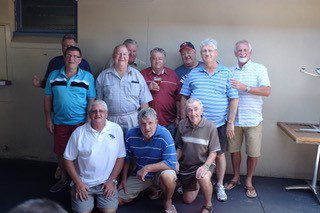
28) PRESENTATION NIGHTS AND SOCIAL DRINKS
As is the ethos of every rugby club over the years we loved to socialise, some would say that we perhaps excelled more at socialising than football, and I suspect there was a degree of truth in that. Our Presentation Nights were a lot of fun but often degenerated into disasters. To help try to get the attendees out at a reasonable hour our Reg Terry and his favourite sidekick Bob Newman used to pull the stem up in the kegs and were able to show that the beer had run out, only to send the stem to the bottom the next day for the small group of workers who turned up to clean up. Furthermore, we often found ourselves having Presentation nights all over the place as we made ourselves unwelcome after our night of fun and revelry. No names or incidences will be mentioned here to protect the innocent, thou I suspect that is a small number.
Beers on Sundays after the game were held anywhere in Stockton and one place, in particular, was in the dressing shed of the old Grandstand, very suspicious to be honest.
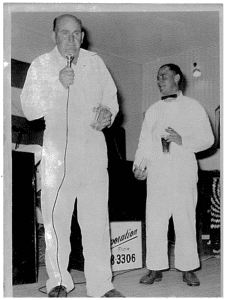
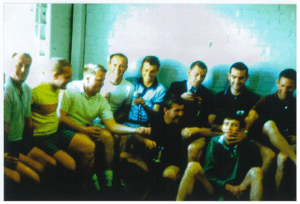
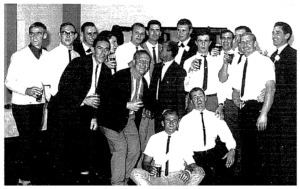
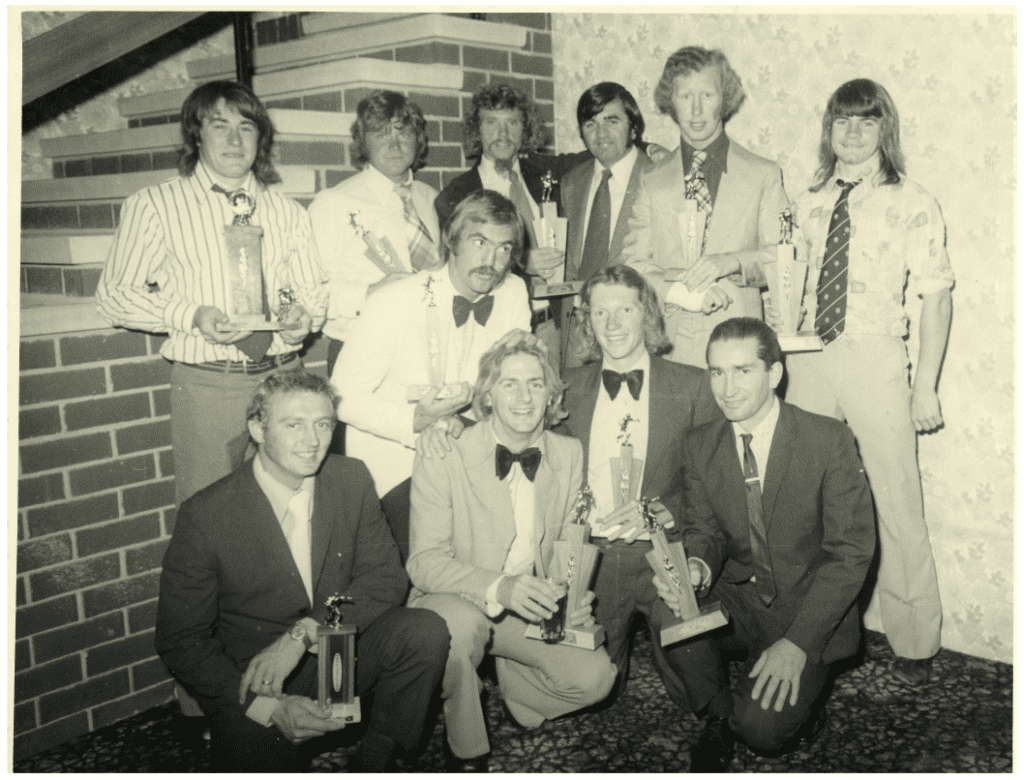

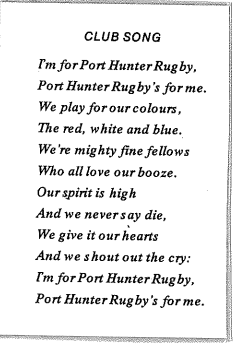
29) RUGBY REUNIONS
Although the club has moved on and is now represented by The Griffins it started to hold reunions in 2005, these have been very successful, and have allowed old mates to catch up and certainly score more tries than the record shows, however, they also show the diminishing numbers as we face the uncertainties of old age. below are just some of the photos of those reunions.

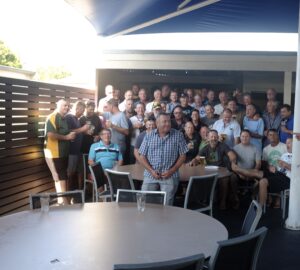
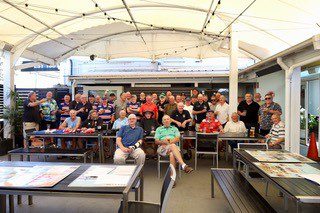
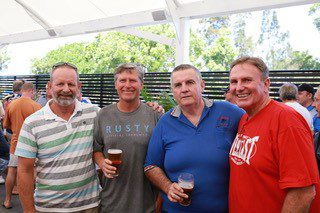
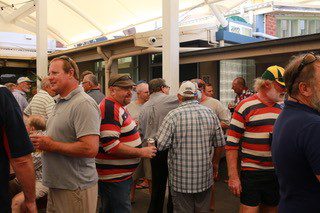
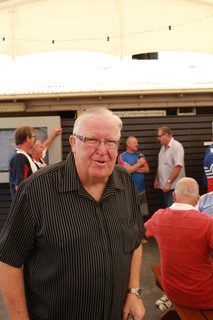

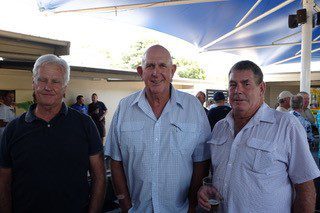
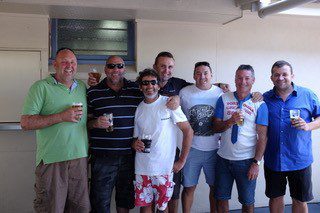

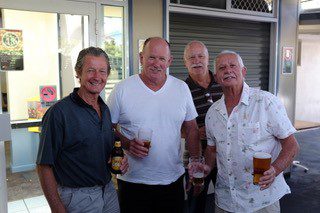
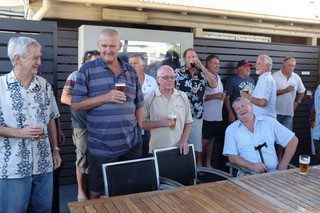
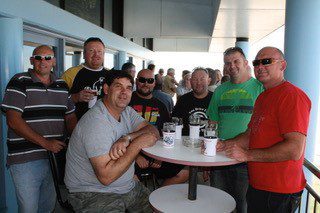
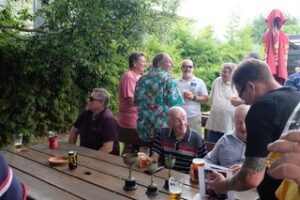
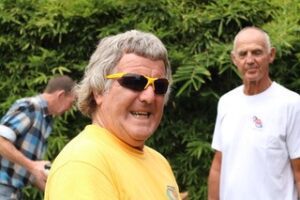
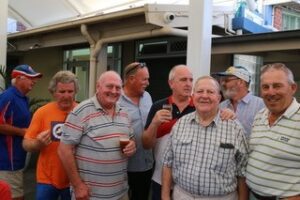
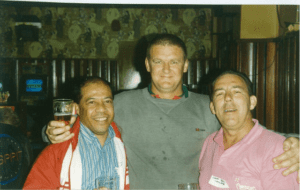
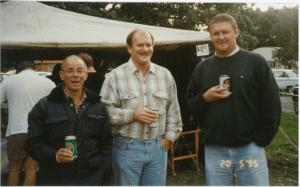
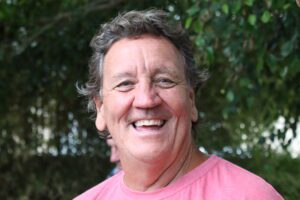

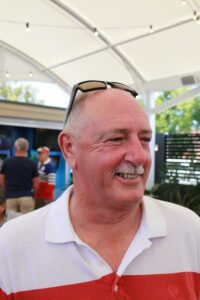
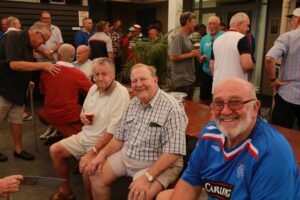
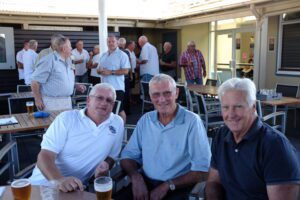
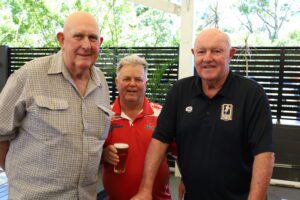
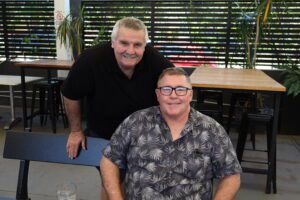
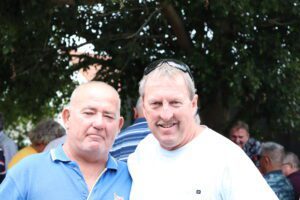
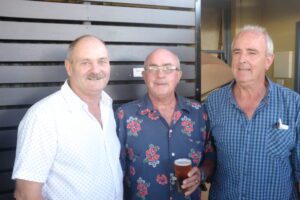
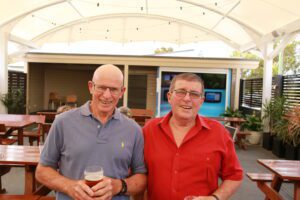
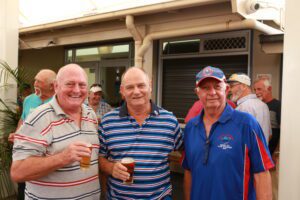




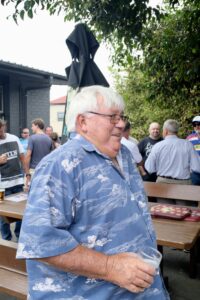
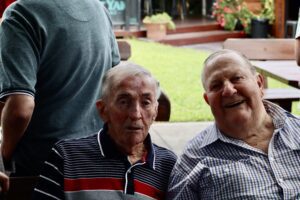

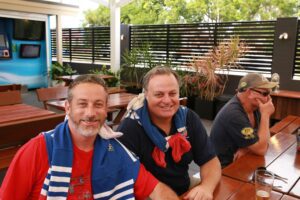

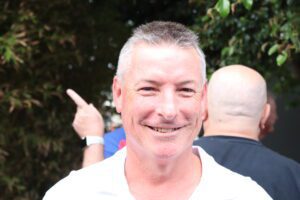
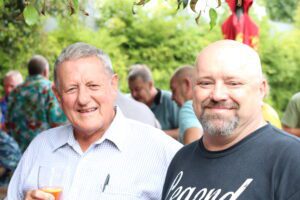
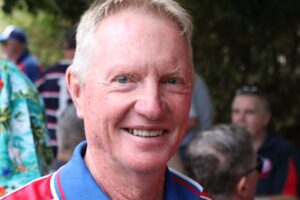
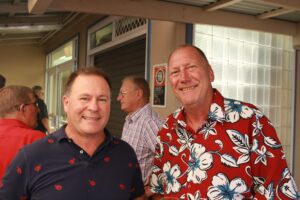
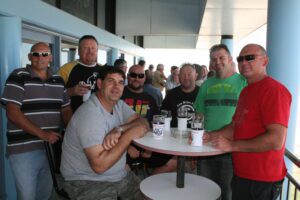
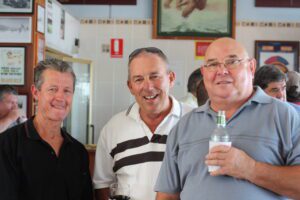
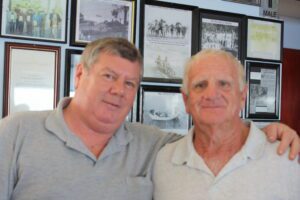
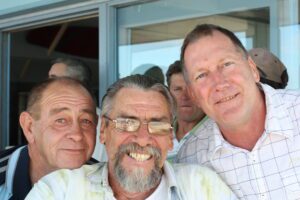
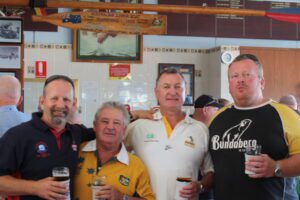


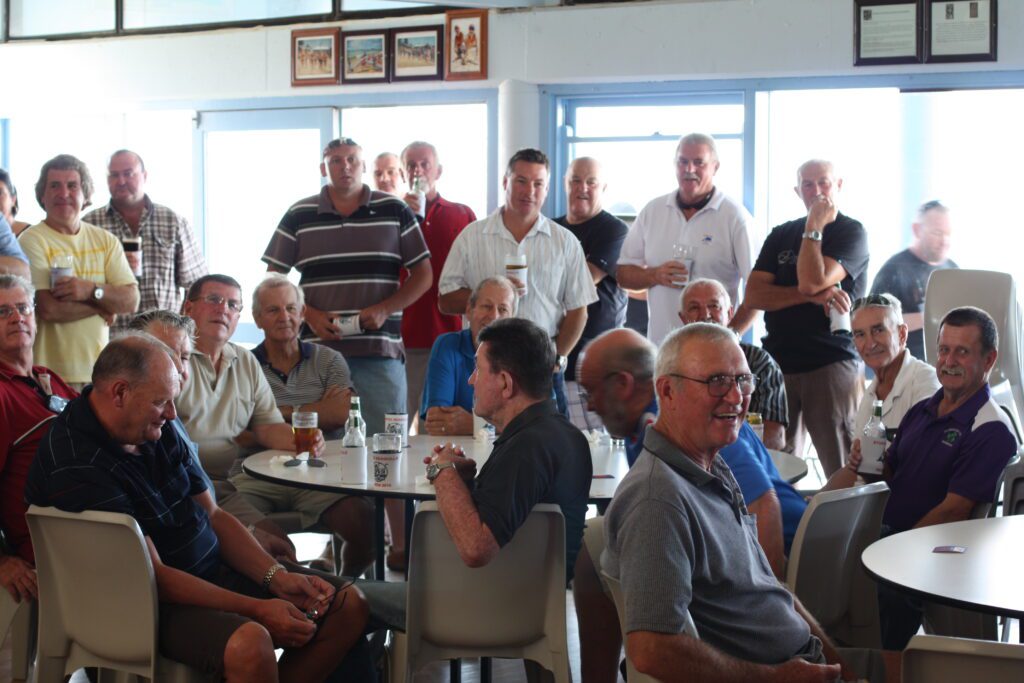
Club Emblem
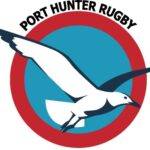
In researching this history I concluded that the club had NEVER had a consistent Club Emblem. Yes we had at least 9 different variations of a seagull in a circle with the colours Red White and Blue, but there was no consistency, Annual Reports, jerseys, drink glasses, and even our ties all had different versions. I also discovered that most of our jerseys never had an emblem on them. I thought this hilarious but so typical of our club. Thus I had a graphic artist draw up an emblem which is presented at the beginning of this document. Whether you agree with it or not it it is our FINAL EMBLEM.
“Truly a Believe it or Not moment.” Brian Rudder
30) ACKNOWLEDGEMENTS
The Stockton/Port Hunter Rugby Club wishes to acknowledge the many people who assisted in the publication of “The Red, White and Blue”.
Although we cannot name all parties, we especially thank the Brady, McNamara, and Bevan families. Newcastle Rugby Stalwart, John Miner, and Wayne Brownlowe for ensuring we kicked our final goal, and Hunter Rugby Union for hosting our history.
Special appreciation goes to the members of the ‘Publication Committee’ Wayne Brownlowe, Brian, and Sue Rudder for their recognition of the task at hand and their diligence in completing the final chapter in recording the history of the club.
31) FULL TIME
The Stockton/Port Hunter Club wishes to acknowledge the many people who assisted in the publication of The Red White and Blue.
It was not an easy task to bring together three installments of a club’s history and blend them into the final document which is The Red White and Blue.
Assistance came without hesitation from many former club members and rugby supporters when the club requested a helping hand, especially when it was realised that the club was honouring the foundation research and writing of Jeff Brady, Peter Mc Namara, and John Bevan from three different periods.
For those who contributed, many thanks for your suggestions, advice, and assistance – we value your input and trust you are pleased with the outcome.
Publication Committee
February 2024
“Three magnificent men, thousands of hours of research, memories, and stories that last a lifetime and beyond, a club made for, and full of characters, at last the history of “The Red White and Blue” has been written, and whilst it may seem to be the end, our history perhaps says otherwise.”
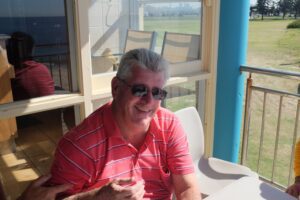

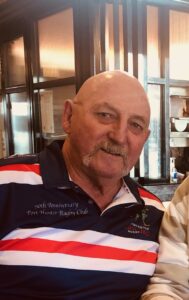
32) References and Bibliography
*BOOKS, PUBLISHED REFERENCES + INFORMATION ON “WWW” GOOGLE
*CRMG, ROSS & TURNER, JOHN – STOCKTON OVER THE YEARS – VOLUME ONE
*STOCKTON LIONS CLUB, NORTHSIDE PRINTING SERVICES 1981
*WILLIAMS, W.K – PRESIDENT STOCKTON LIONS CLUB, 1981
*TROVE (trove.nla.gov.au) https //trove.nla.gov.au.
*CLASSIC WALLABIES (https//classicwallabies.com.au.)
*STOCKTON HISTORICAL SOCIETY (especially Cherylanne Bailey)
* LOCAL NEWSPAPERS – (PRESS CLIPPINGS etc)
*NEWCASTLE MORNING HERALD – MINERS ADVOCATE
*NEWCASTLE SUN.
*PORTSIDE LOCAL
*MAITLAND MERCURY
“STORIES FROM THE FRONT ROW-BELIEVE IT OR NOT” Supplied By:
L.MAHER, L.DAY, B.RUDDER, D.HAYMAN, I.CARTWRIGHT, J.M.BEVAN, T.DAVIES, G.ROLSTON
CLUB REFERENCES
Available Minutes, Register Books, Various club photos, other documents, and information found and archived by Mrs. M Jackson, as of January 2023. As well as information supplied by past and present players and administration listed below.
B.RUDDER, T.TRENCH, K.JACKSON, MARGARET JACKSON, B.GRIFFITHS, A.BARKER,
K.GRAINGER, I.CARTWRIGHT, M.CARPENTER.
P.QUINN, C.REID, M.REID, D.HADDOCK, K.COOPER, E.WORRELL, J.NEWTON, T.DELBRIDGE.
S.O’NEILL, D.TERRY, G.COX, R.GORST, N.STIRRAT, J.DENNIS, REG STOKES, S.ALLISON, T.DAVIES,
W.ROBSON, W.JACKSON, L.DAY, P.MCNAMARA, D.HAYMAN.



